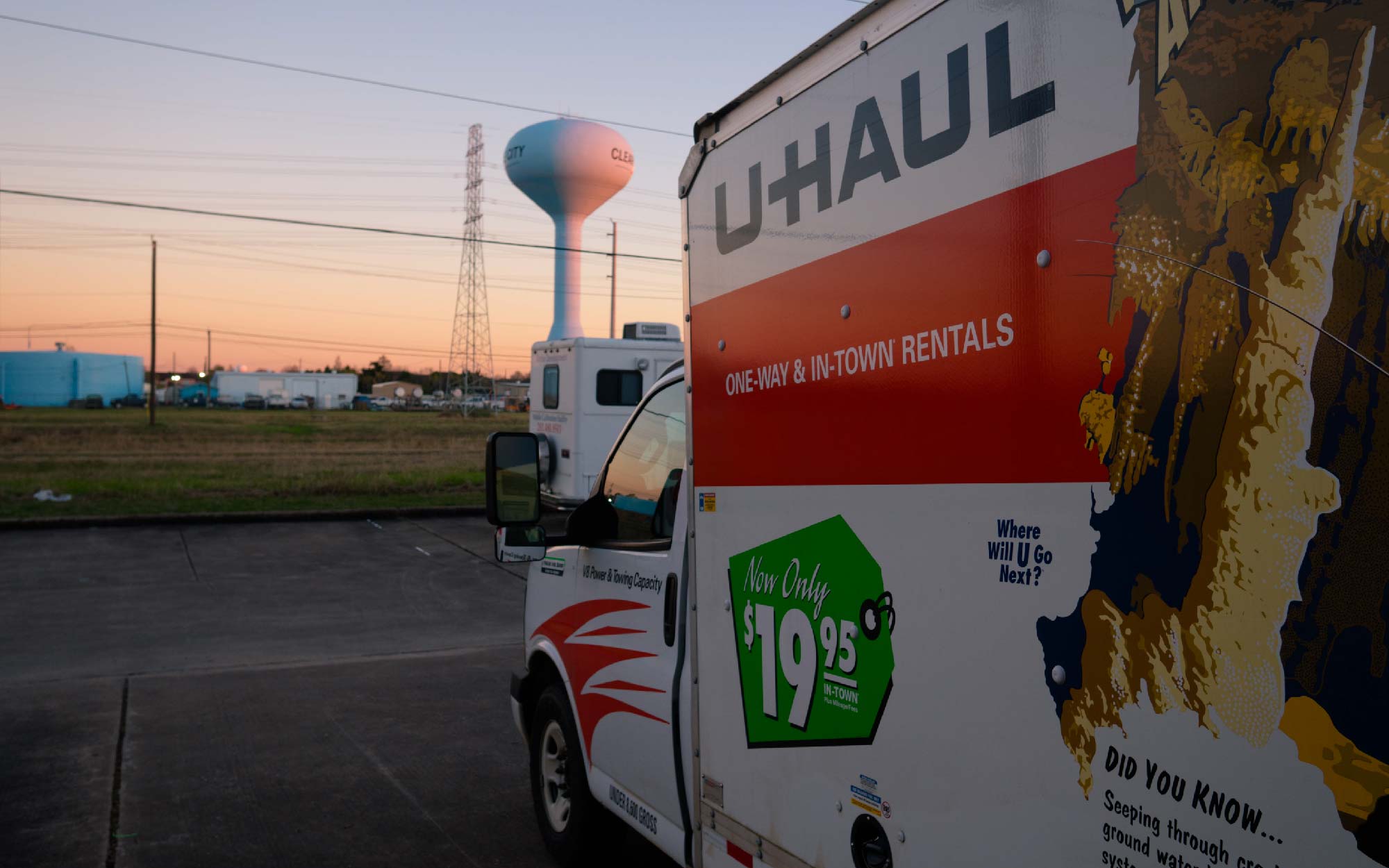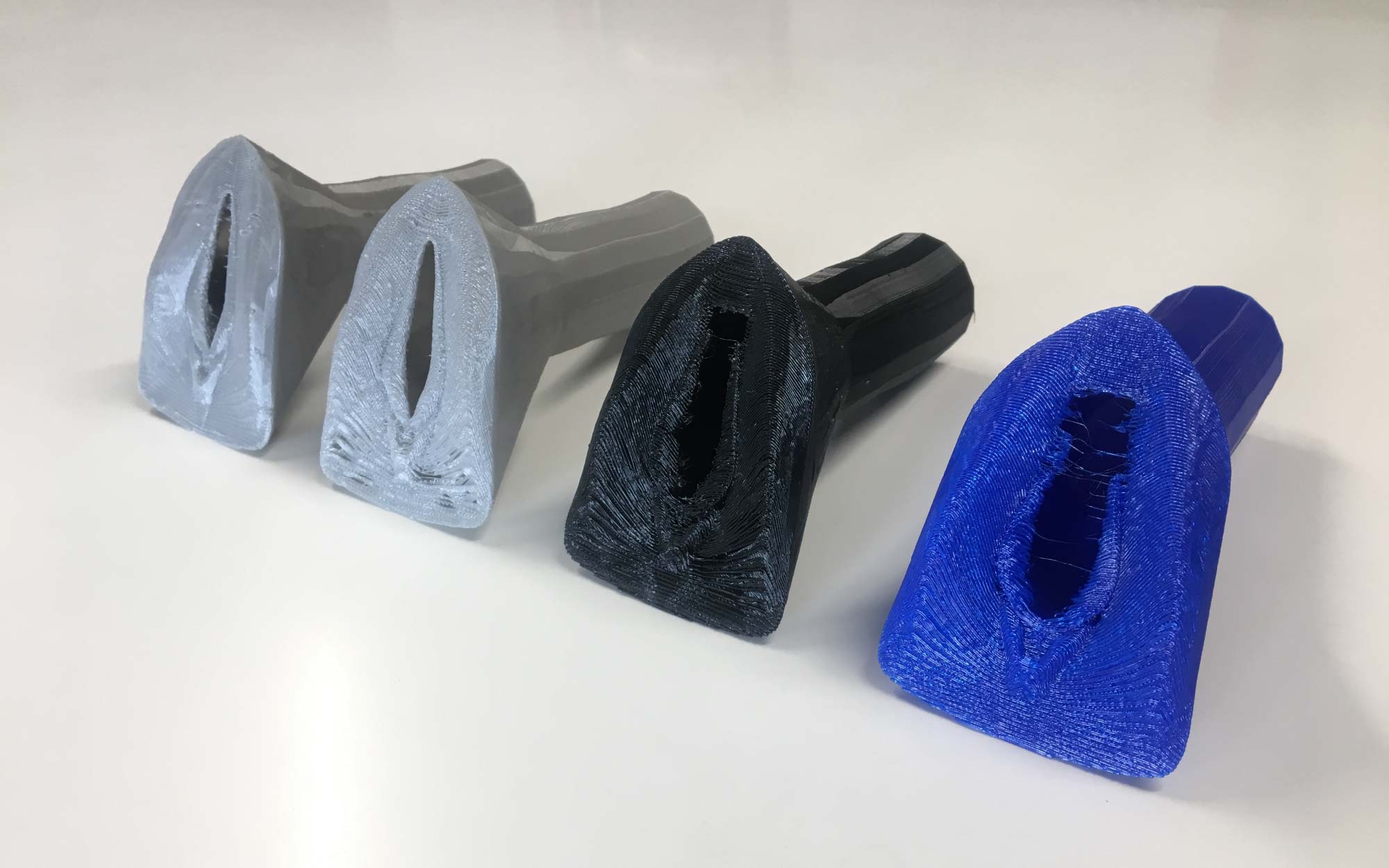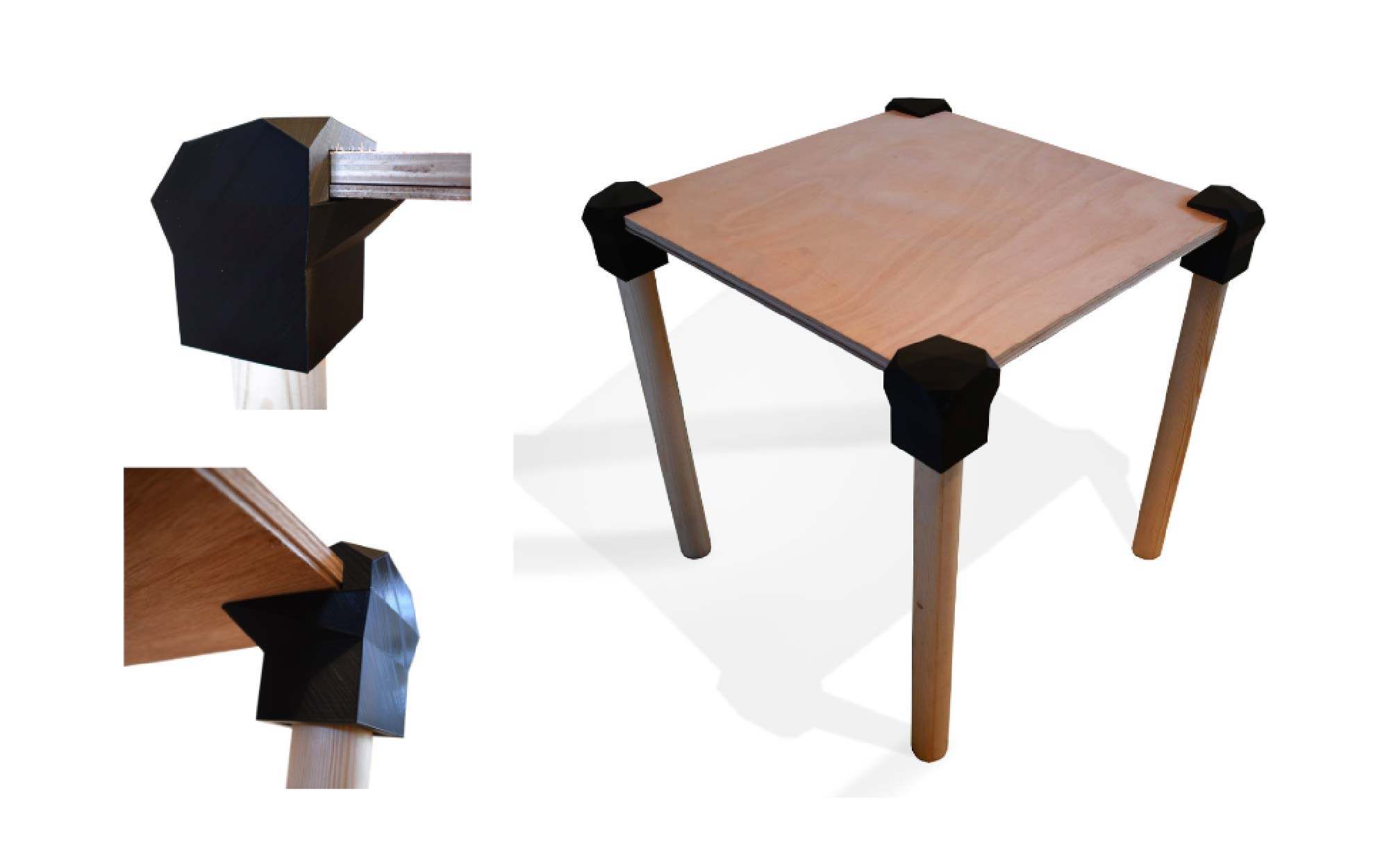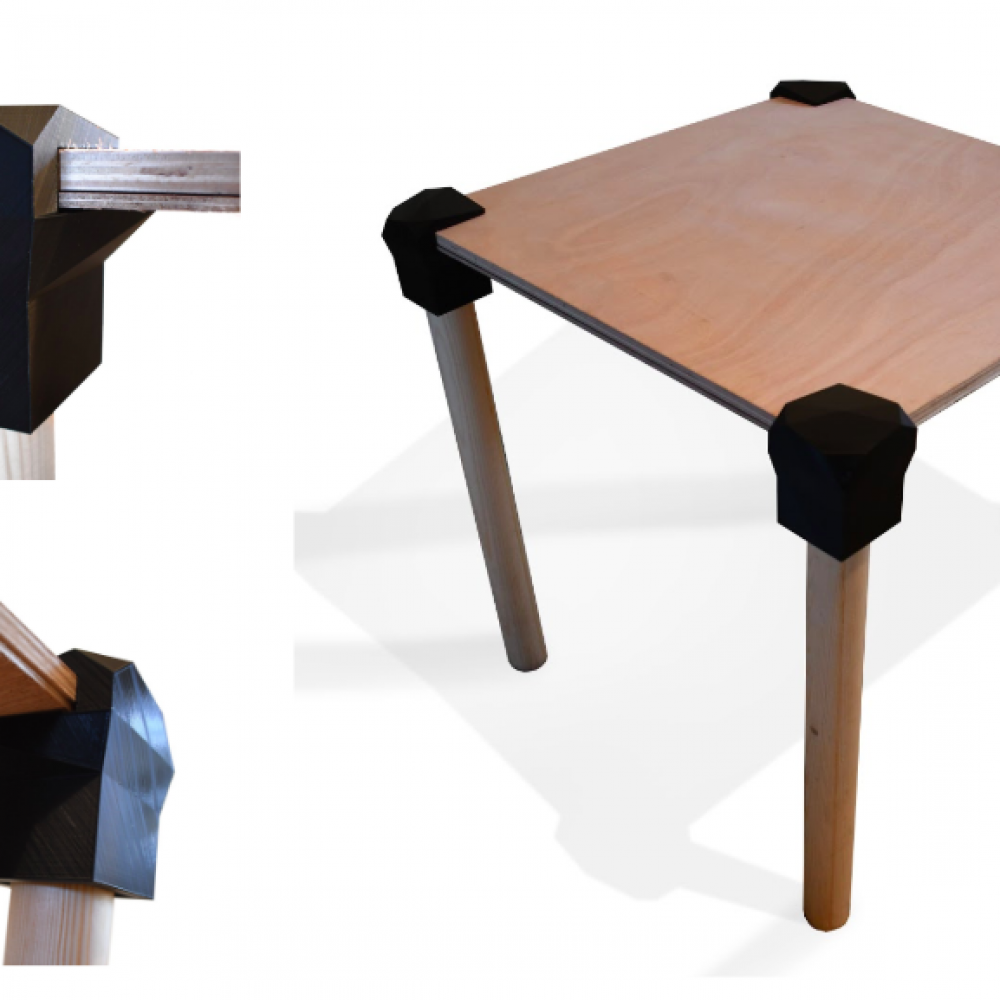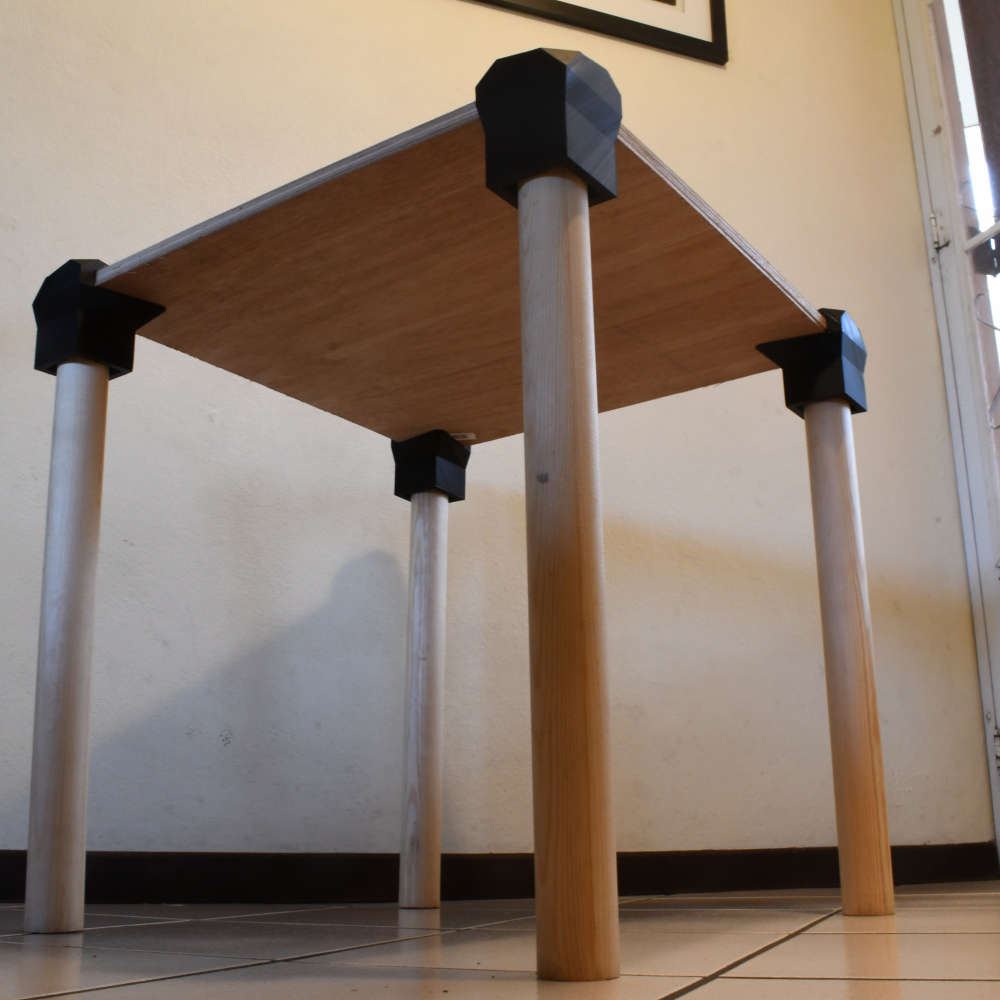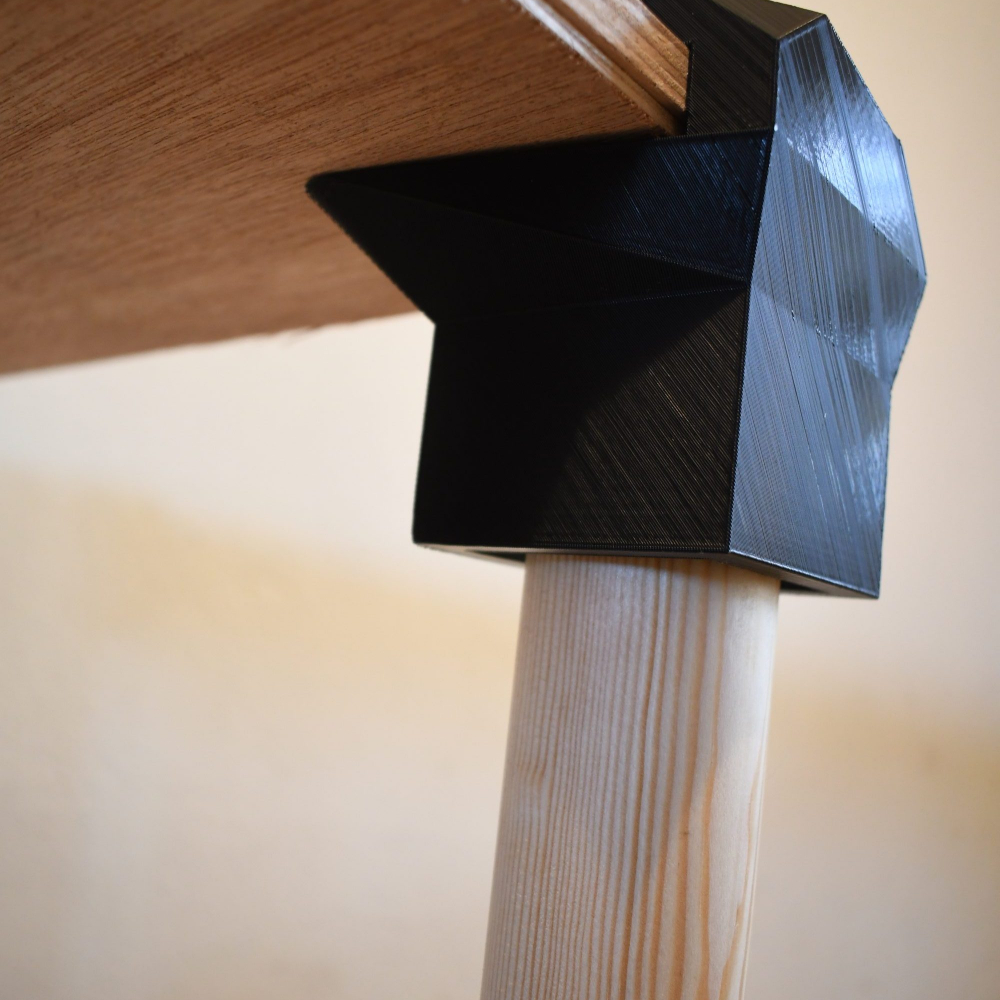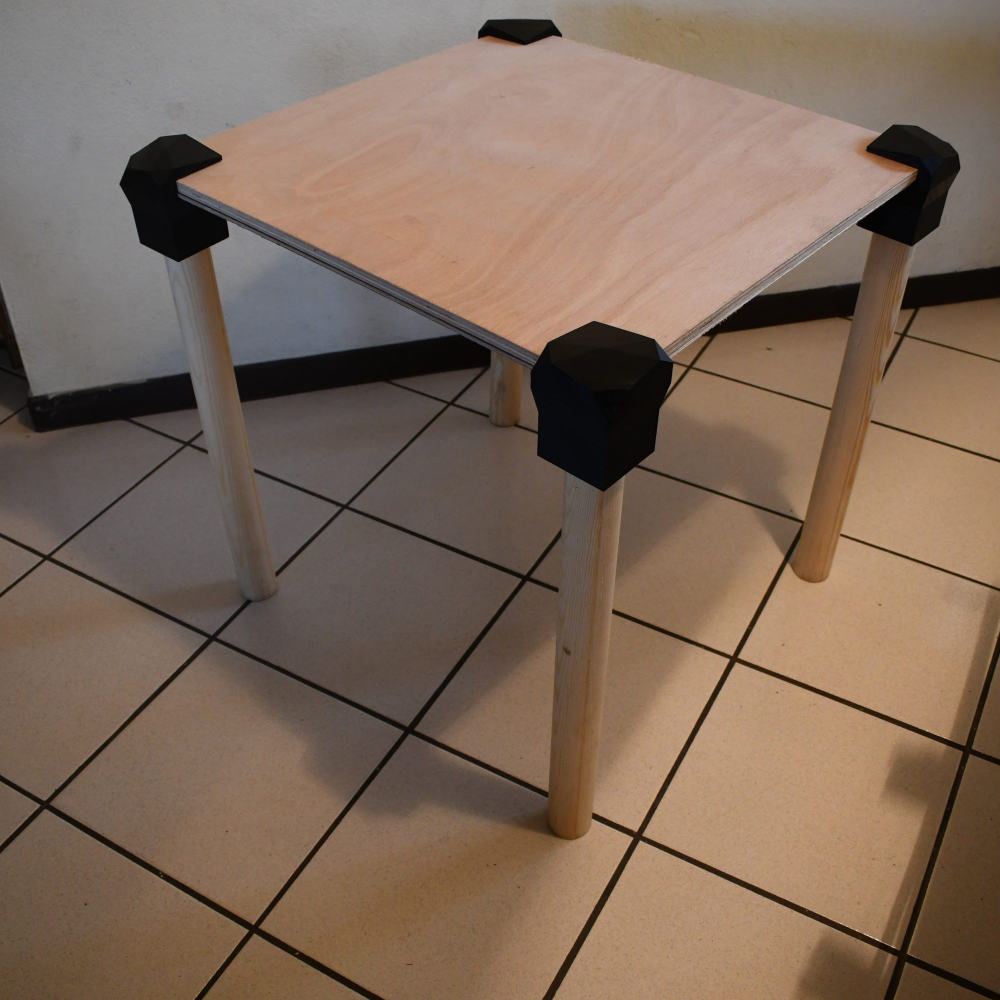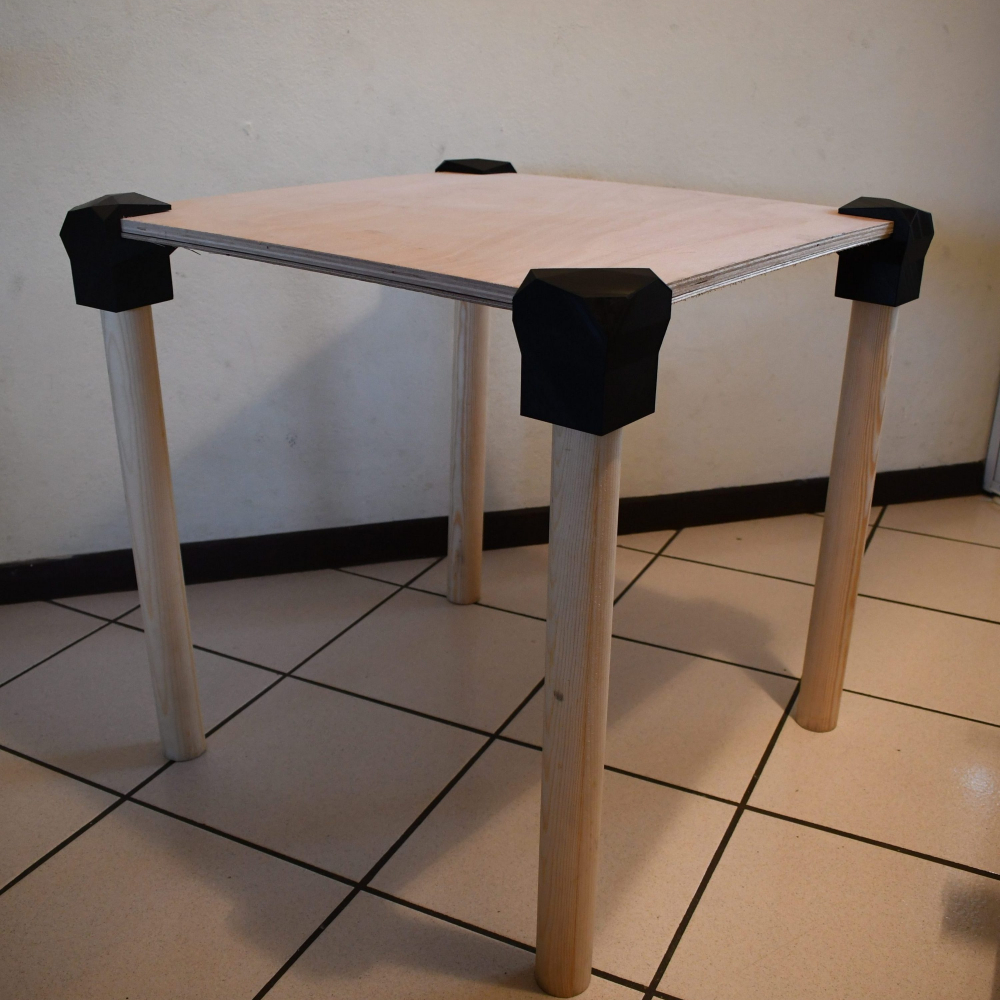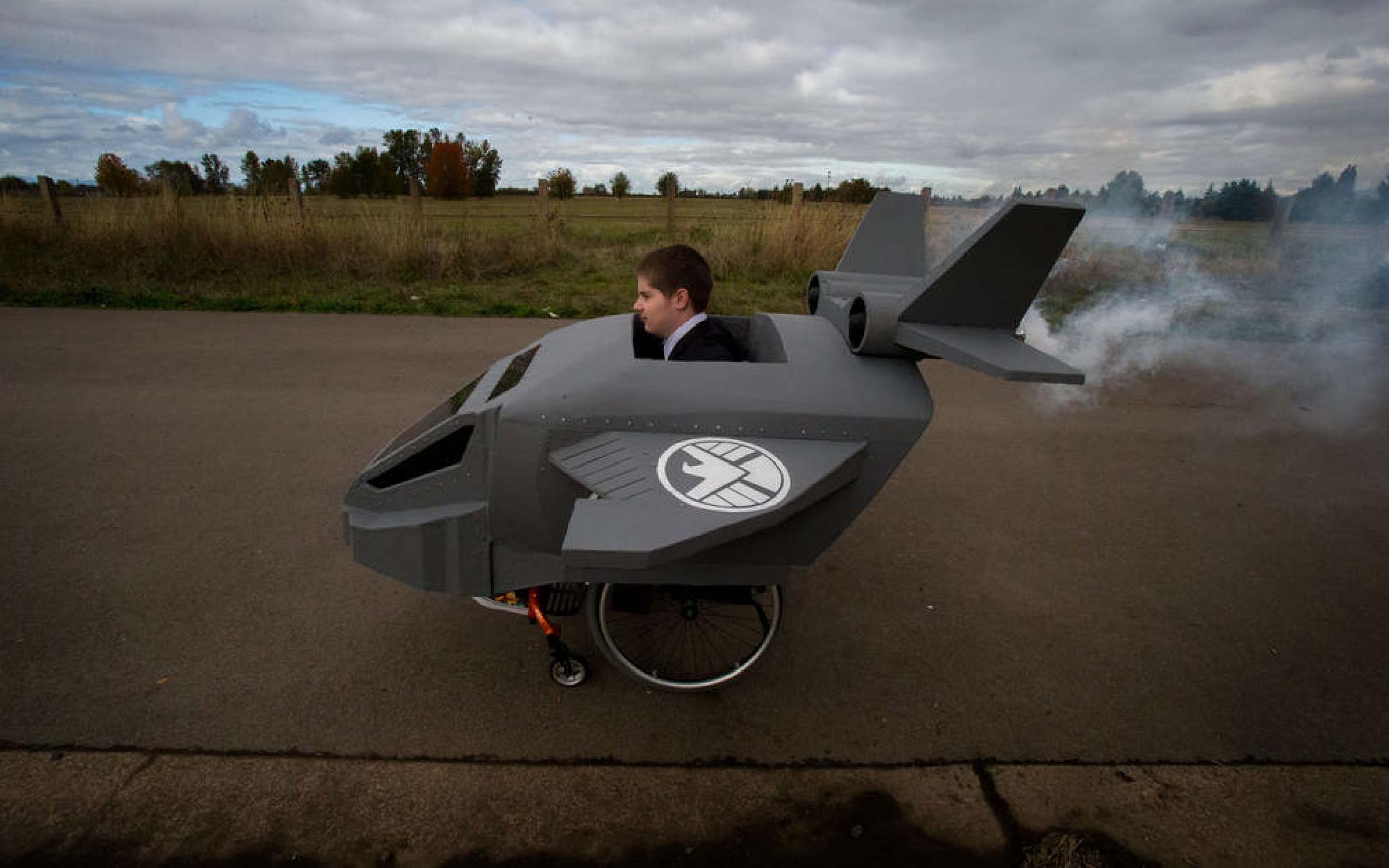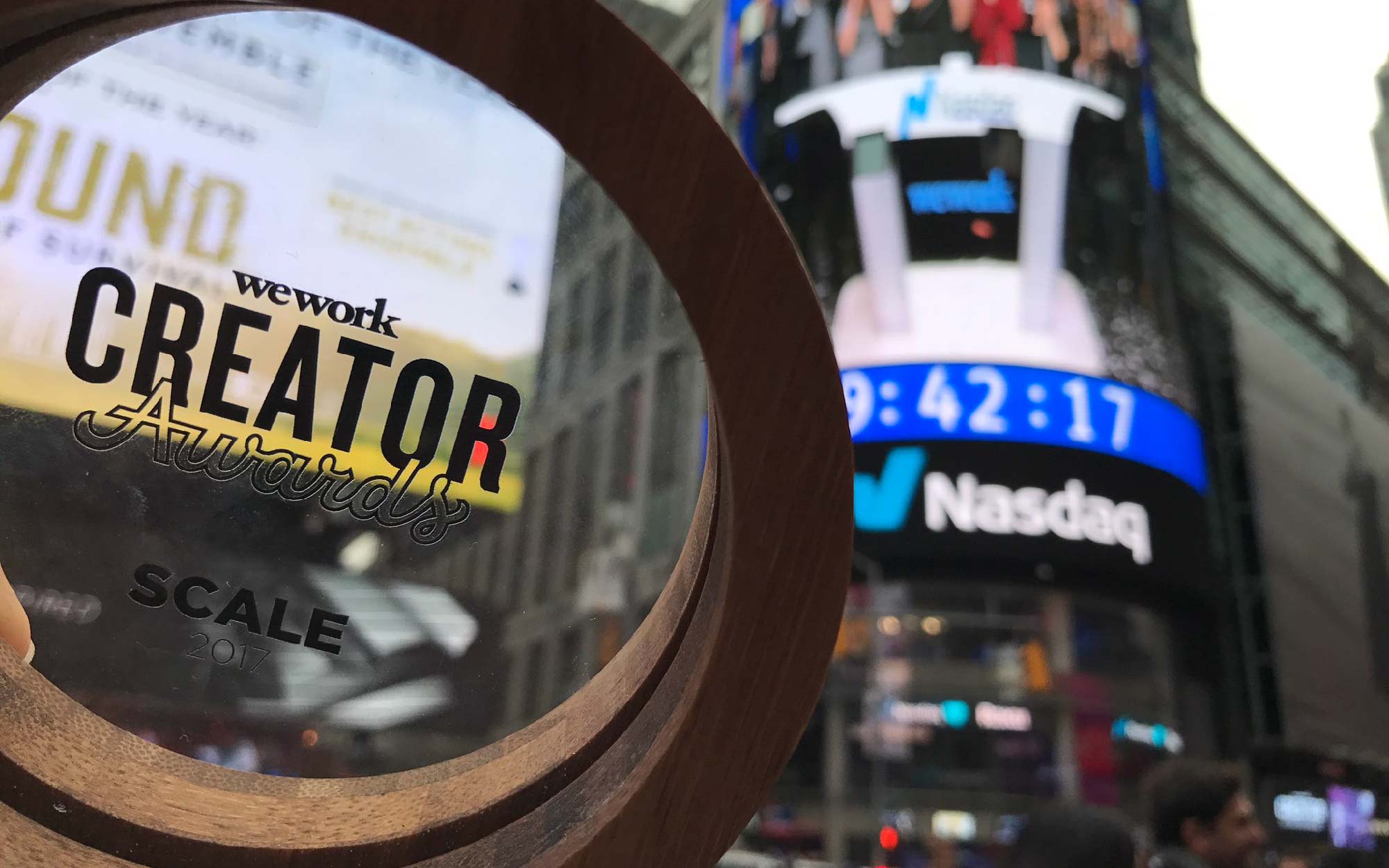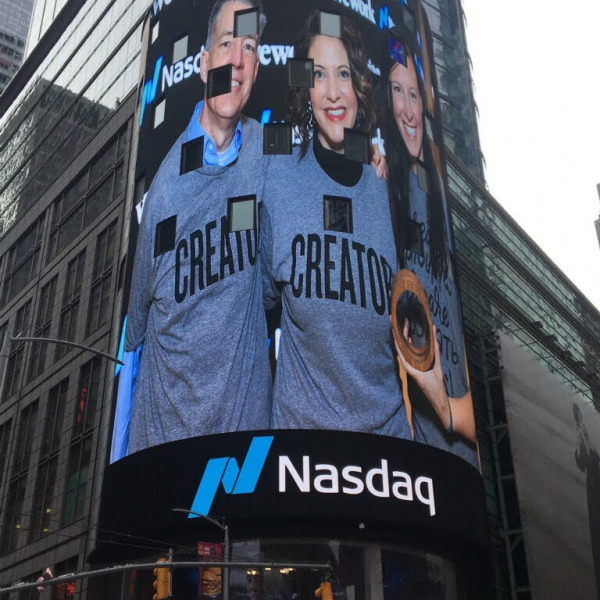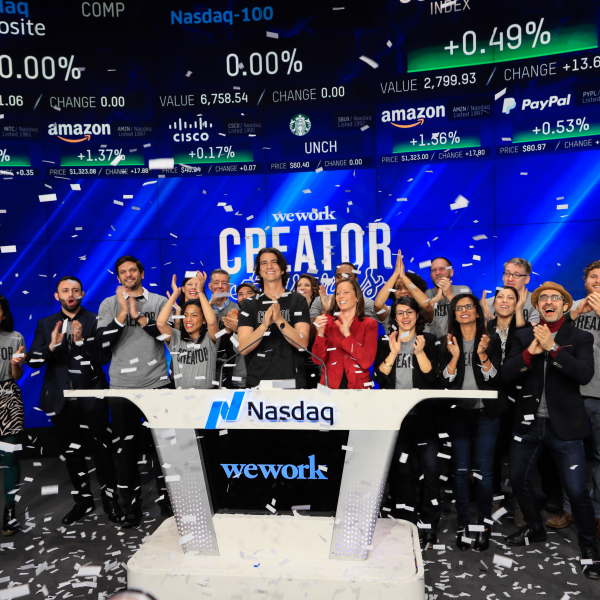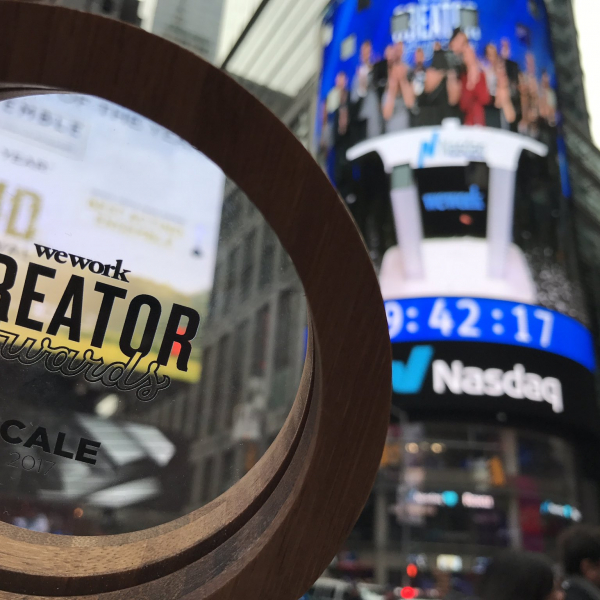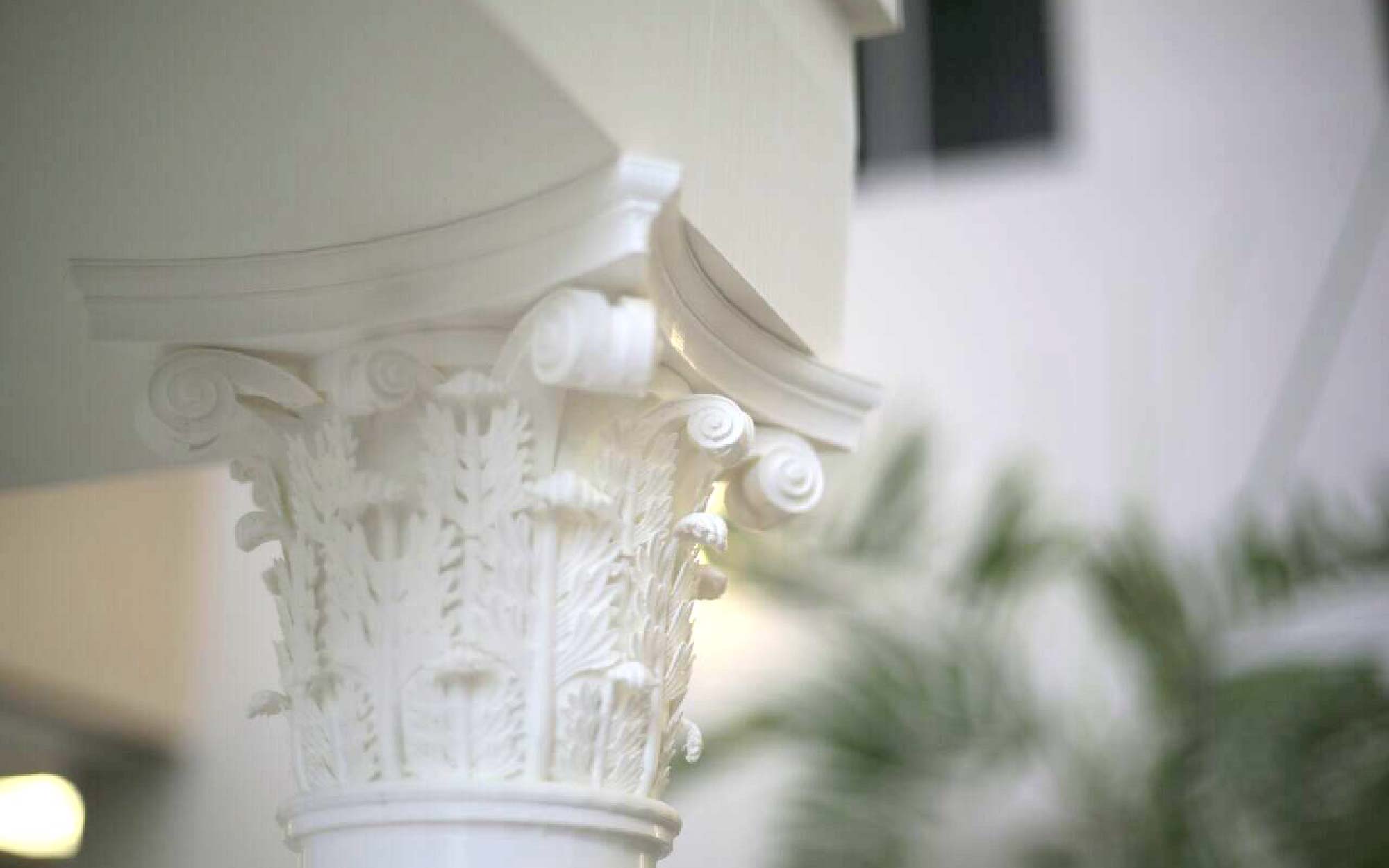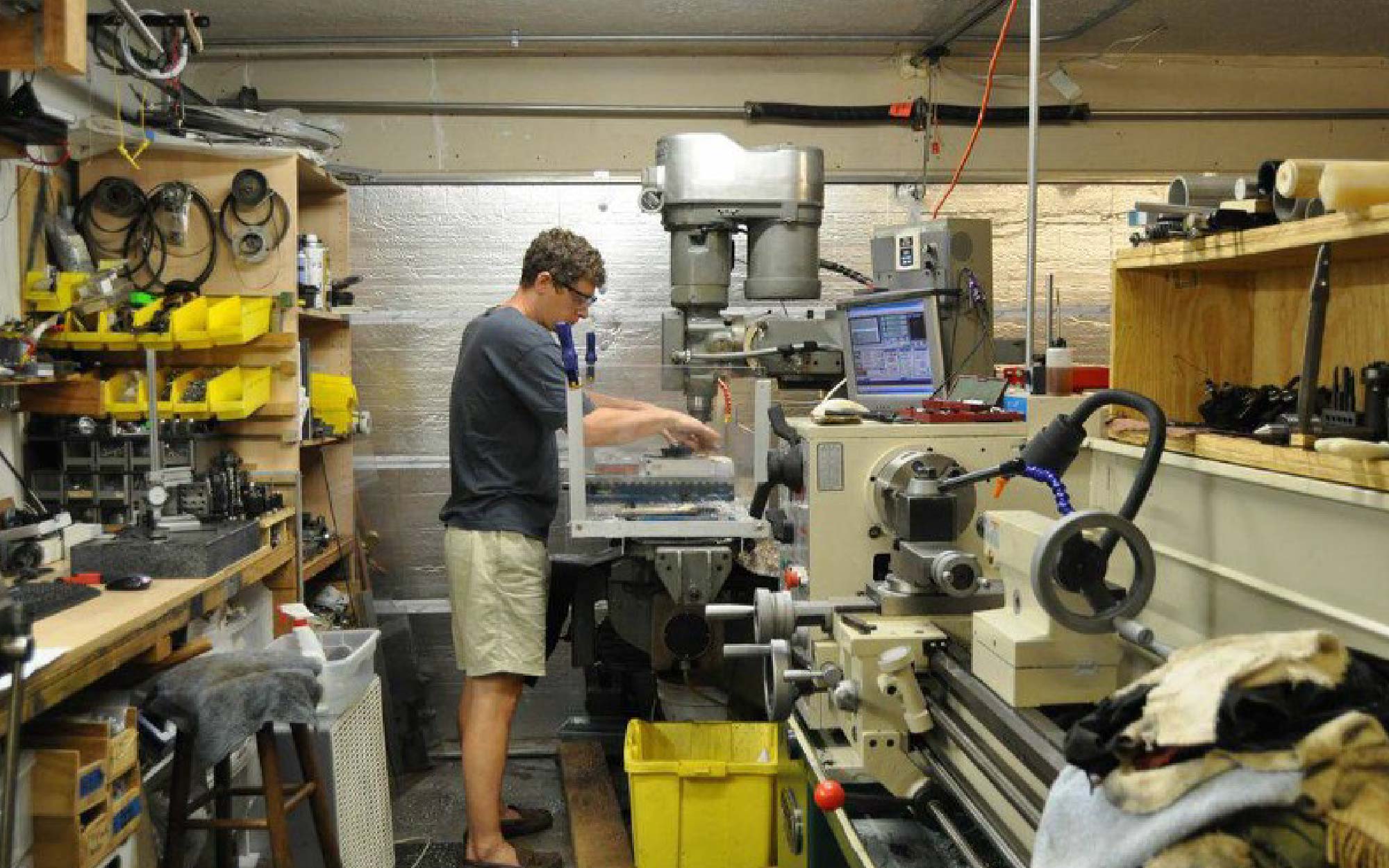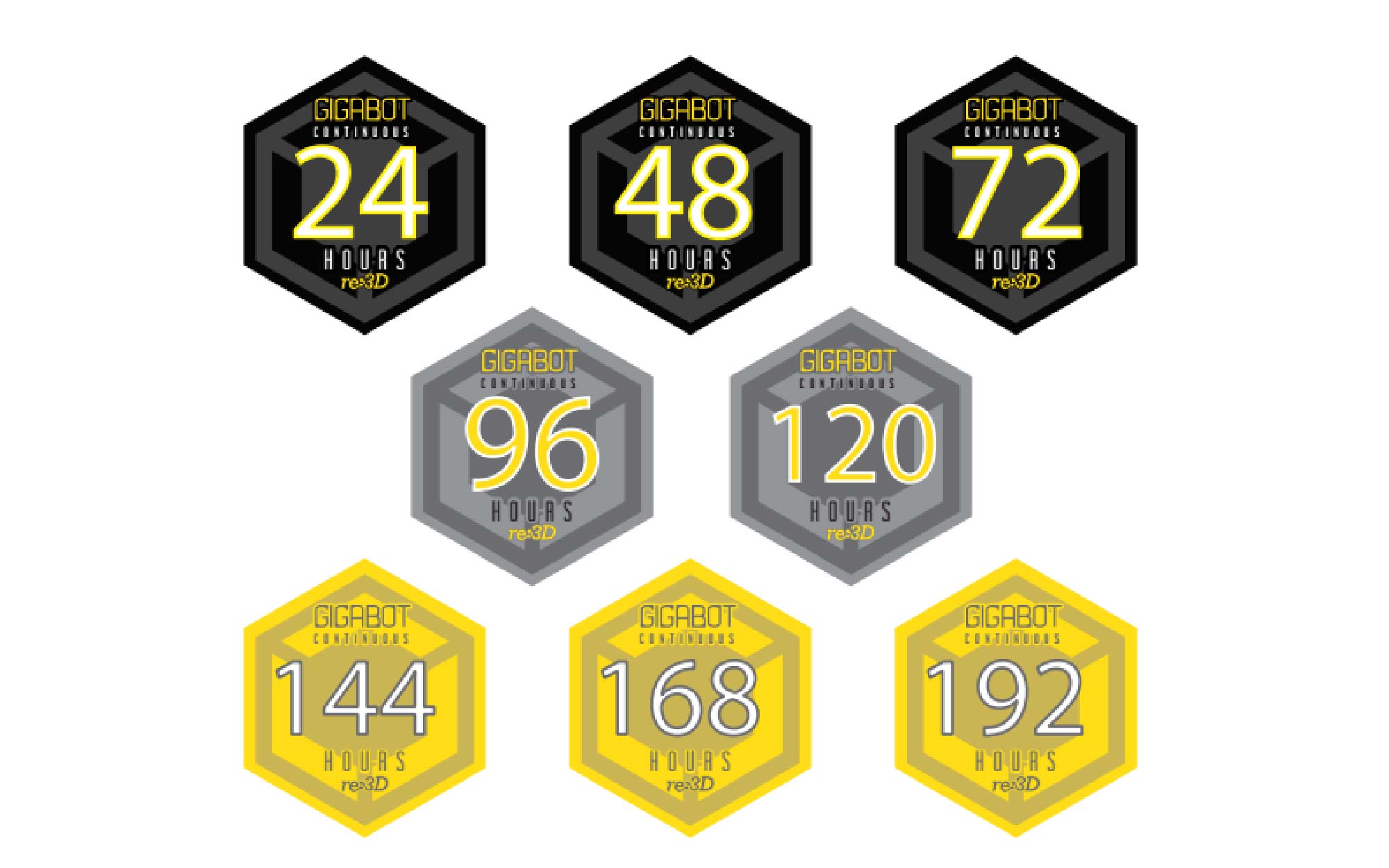On the road to CES 2019! Here’s our schedule.
Continue readingMedical Models For Disaster Response: Why We Designed and 3D Printed Flexible Vaginas
Nearly a year ago, Hurricane Maria devastated Puerto Rico with its Category 5 power. The entire electrical grid was destroyed, water systems were inoperable, 95% of cellular sites were broken and 400 miles of Puerto Rico’s 16,700 miles of roads were too damaged to drive on causing thousands of people and communities isolated from communications and disaster relief.
While the island experienced many problems, many problem solvers stepped up to respond and local grassroots relief and recovery efforts formed immediately. One local organization, Colectiva Feminista en Construccion – a political organization advocating for women’s rights and protesting capitalistic and patriarchal oppression– opened up a fund and set up a center in an abandoned building in San Juan to distribute supplies to the community. But they didn’t stop there.“We don’t want to be just a band-aid,” shared one of the organizers, Maricarmen Rodriguez, “We want to help everyone and create a more inclusive society. Hurricane Maria cleared the makeup that was covering up problems that were already in Puerto Rico.”
One of those problems surfaced while providing feminine hygiene products and realizing the need for medical models to teach about aspects of the vagina and how to use products like Diva Cups. More than that, Maricarmen wanted to find a way to talk about menstrual cups and sexual education that is often taboo in society.
Could 3D printed vaginas be a tool for more grassroots sexual education?
When you look for your typical sex ed class medical models, they can cost hundreds per piece and the industry is monopolized by a small number of manufacturers. These models are made from unforgiving plastics that lack usability and plasticity to use to demonstrate with products like Diva Cups. Not to mention, in post-hurricane conditions, importing products like these would have been nearly impossible and taken months to arrive.
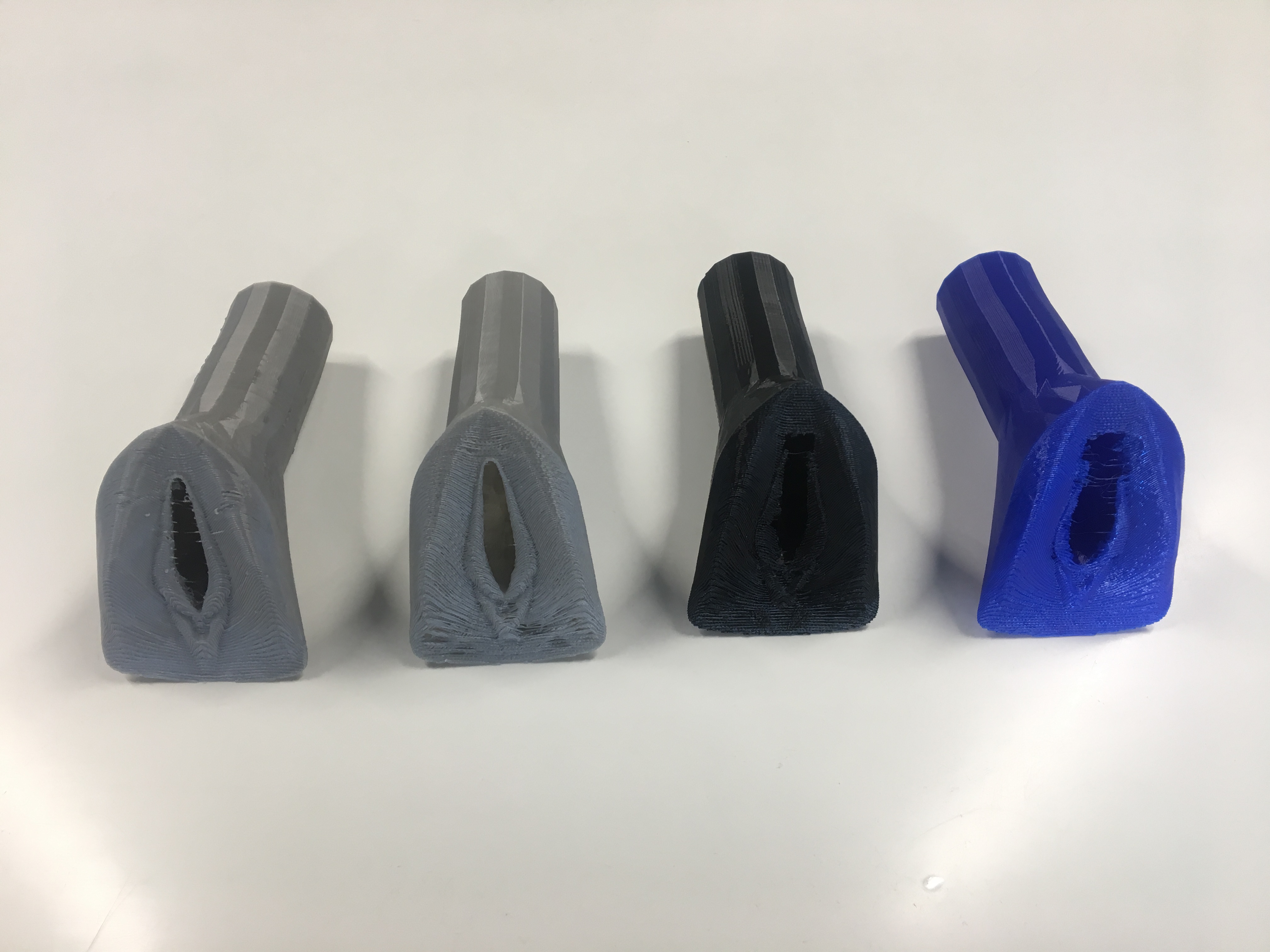
So Maricarmen reached out to re:3D in Puerto Rico and our teammate Alessandra set out to 3D print vaginas.
Right now, there are no open source vagina medical models so Alessandra started from scratch by creating a 2D picture by tracing from a medical book. She then used Rhino to create a 3D model.
The 3D printed vaginas – printed from flexible materials such as Ninjaflex and semi Flex making them more durable and less likely to break – provide more realistic and life-like medical models.
These 3D printed medical models have the ability to be just as realistic with attention to detail at a fraction of the cost: only $20-30 per print. The prints took about 3 hours on Gigabot – making body parts accessible nearly on demand.
This opens up new possibilities for schools, hospitals, and grassroots organizations to have access to affordable teaching tools – before a disaster and to aid in recovery and education after and beyond.
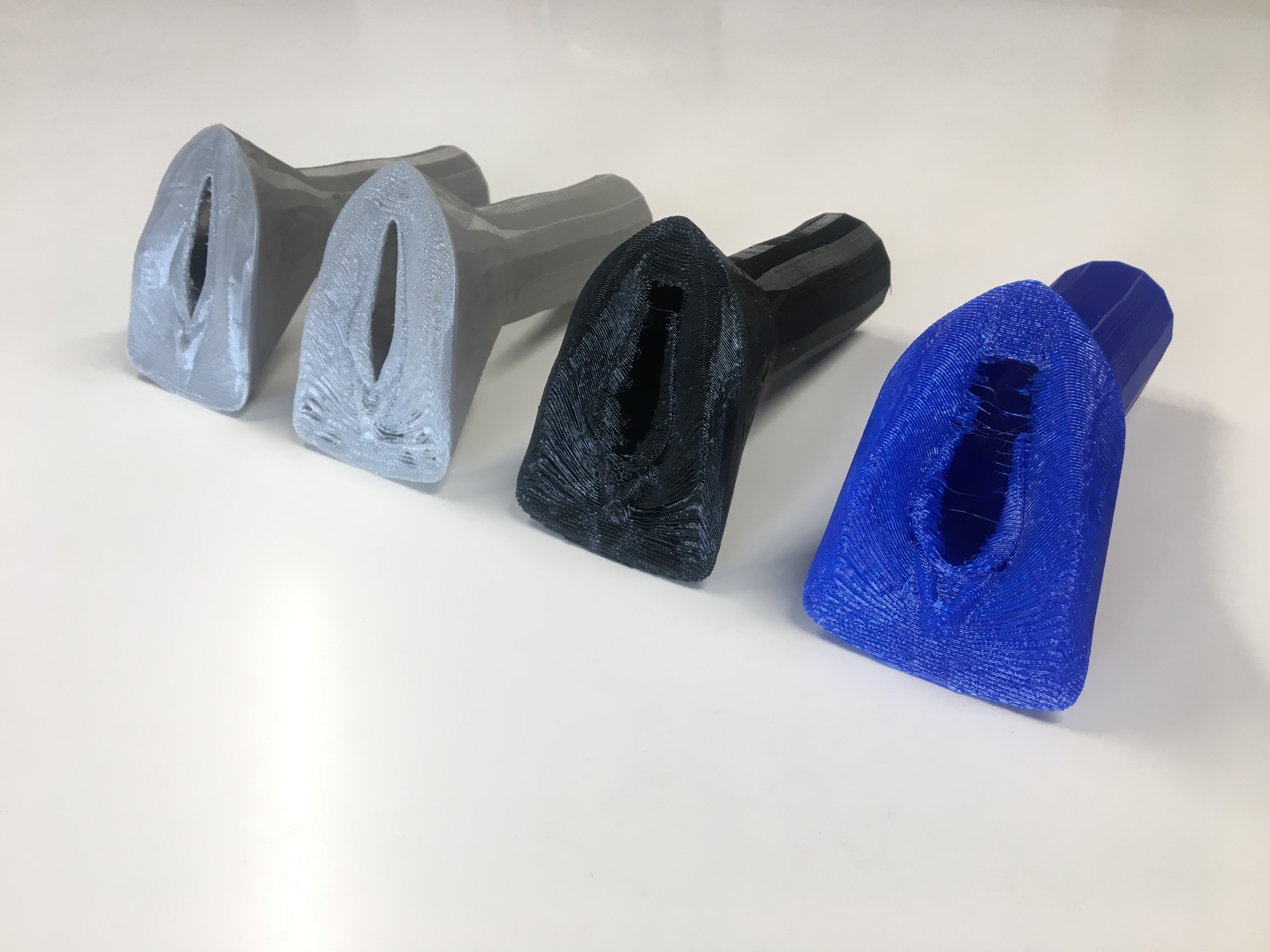
Watch the 1-minute video of Alessandra explaining the 3D printed vaginas
re:3D had a #HurricaneStrong year in 2017 – our Houston team was hit by Harvey and our team in Puerto Rico withstood Hurricane Irma and Hurricane Maria. June 1st marks the official beginning of hurricane season in Puerto Rico and in this series, we are highlighting stories of impact and insight to encourage #3DPrintedPreparedness this year.
Cat George
Blog Post Author
And The Winner Is… Results of the Fast Furniture Challenge
As you may have seen, we launched a global 3D printing contest this summer in pursuit of finding a 3D printed solution to quickly assemble furniture in preparation for this year’s hurricane season. Called the “Fast Furniture Challenge”, we opened up this problem to our global community in exchange for a $250 cash prize.
Applicants were judged on a set of criteria including print time, cost, materials restrictions, weight load, and ease of assembly. Winning prints had a print time of under 48 hours, cost less than $20 to print, and were easy to assemble and disassemble using only pre-cut wood from Home Depot for the final piece of furniture to hold at least 150 pounds.
Participants submitted .STL files and digital presentation boards and our team judged the designs based on each design’s creativity, presentation board, .STL quality, estimated print time and ability to print without supports. The top designs were then printed and put to the test – the final product was judged on the ability to withstand 150 pounds, how easy it was to assemble and the cost of the print.
We’re excited to announce our winner…drumroll, please…Sylvain Fages! Sylvain’s design printed a set of joints (4 joints = 1 table) in 12.08 hours, using 1.07 lbs of PLA for a $20.21 material cost. The prints had 15% rectilinear infill and no supports were needed. Also, shout out to the runner-up: Daniel Alvarado from ORION.
Below you’ll see some snapshots and assembly footage from Sylvain’s winning design and the final product our teammate Alessandra put to the test.
Reviewing Design Boards & .STL files
Sylvain submitted two design presentation boards (you can also access the original Sylvain Designs PDF).
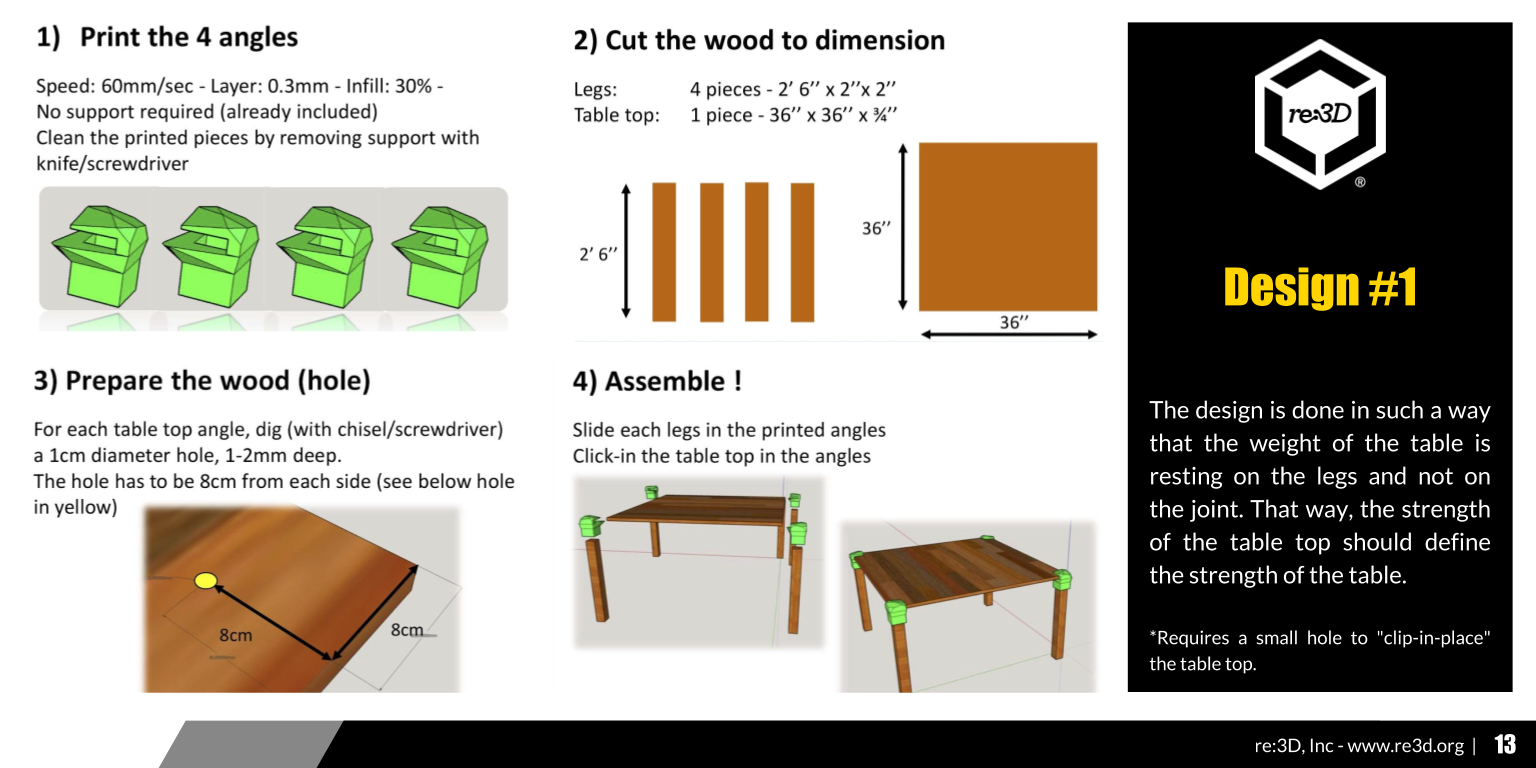
Design #1 was done in such a way that the weight of the table is resting on the legs and not on the joint. That way, the strength of the table top should define the strength of the table; however, requires a small hole to “clip-in-place” the table top.
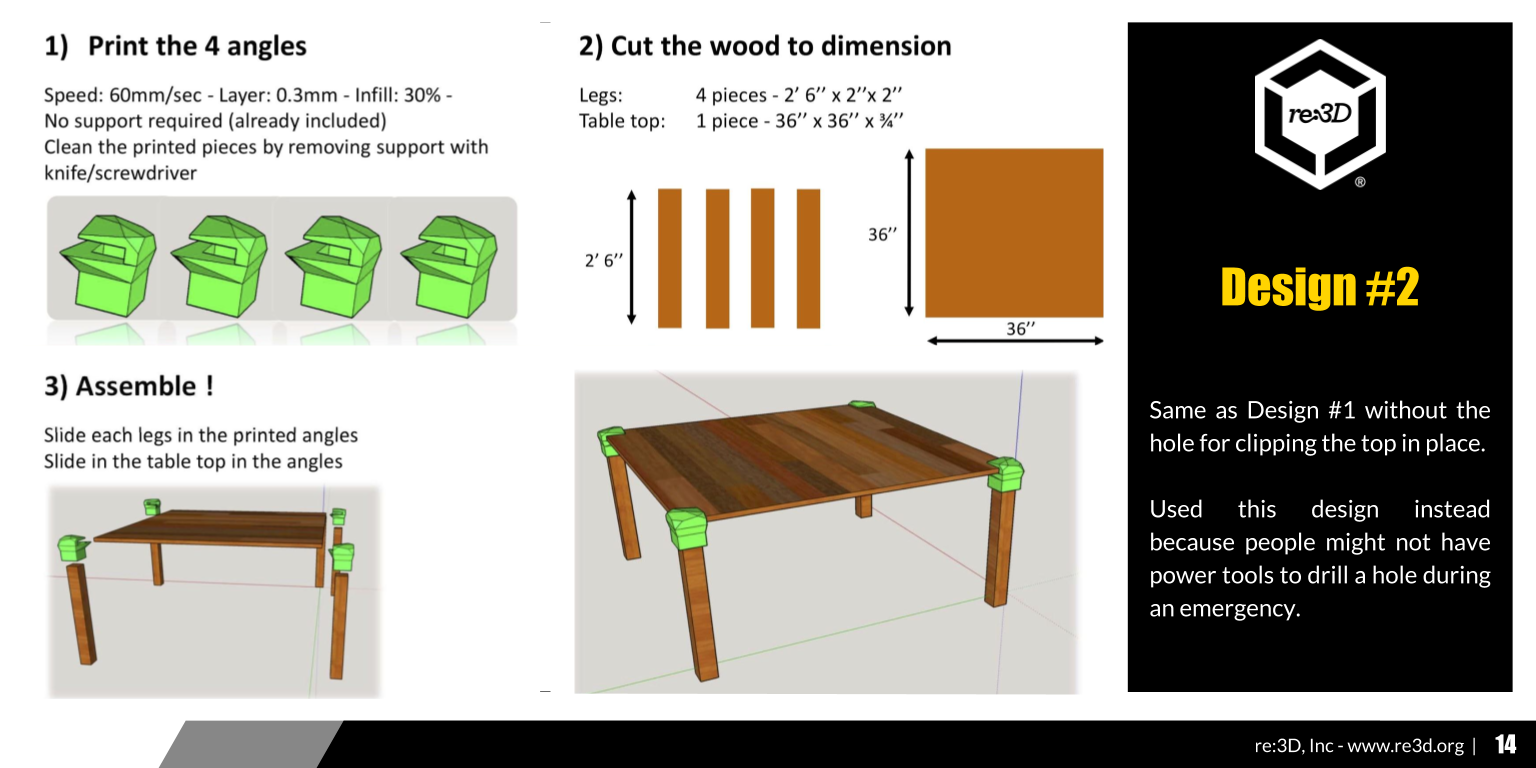
Design #2 is almost the same as design #1 but without the hole for clipping the top in place. Design #2 was selected for printing as it does not require access to power tools that may not be available to people during emergencies.
.STL file review & slicing revealed the model was watertight with no errors and can be printed without supports, due to its unique design.
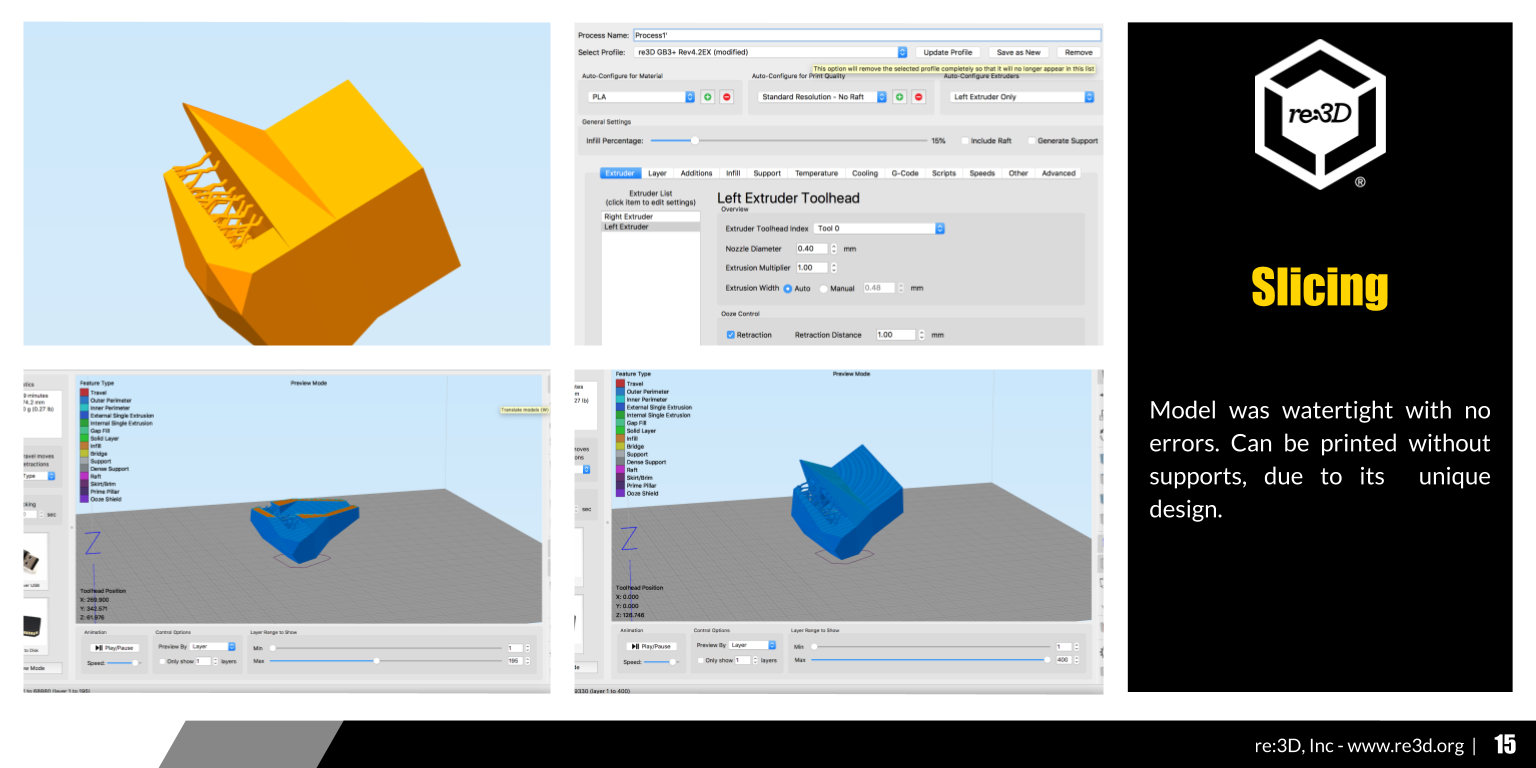
Testing the Joints
After selecting the top designs, we put them to the test by 3D printing them and assembling tables using pre-cut wood from Home Depot to evaluate ease of assembly, their stability and ability to hold up to 150 pounds. Here’s footage from Sylvain’s printed designs:
3D Printed Joints Table Assembly Video: Ease of assembly was an important factor in choosing the winner, watch Alessandra assemble a table w/ Sylvain’s 3D printed joints
Weight Test Video: We also tested that the table could hold up to 150 lbs.
Table Stability Video: Alessandra tested the level of the table’s stability.
Final Product Photos
Here are some snapshots of the joints in action after the table was assembled. Click to view bigger photos.
Lessons + Insights
As you may have seen in our first post announcing this challenge, this Fast Furniture challenge was inspired by personal experiences our team endured during Hurricane Irma and Maria which we will continue to be sharing in our 3D printing recovery series. We ourselves went through rounds of trial and error to find a 3D printed solution to assemble furniture quickly – which was one of the biggest requests in the aftermath of Hurricane Maria. I caught up with our teammate Alessandra who shared some lessons from our experience and learnings from this challenge. Here are her key takeaways:
- Joints with 3/8″ wall thickness are very resistant to breaking. Previously, we were using 1/8″-1/4″ wall thickness for joints and they weren’t as strong as Sylvain’s. That extra 1/8″ does the trick!
- The configuration of the joints allows the table top to rest on the wooden legs and not the 3D printed joints, which greatly reduces its probability of breaking.
- No matter how thick the 3D printed part is, braces are needed for full stability.
We asked Sylvain his motivation for 3D printing and entering this challenge, he shared, “Since I discovered 3D printing through a blog article about fixing a stroller back in 2014, I have always been fascinated by how much you can do and build! I bought (and built) my first printer in 2015 and have since then always admire the possibilities you have with of 3D printing, especially to fix, recycle, and reuse things. When I heard about this challenge, I could not resist but to participate! Using 3D printers to improve our world and help people – this is my vision of a 3D printer at its best!” You can view more from Sylvain on Instagram and Thingiverse.
If you have more questions, you can tune in to more discussion on 3D printing fast furniture on our forum and stay tuned for future 3D printing contests by following us on social media @re3Dprinting on Facebook, Twitter, Instagram and sign up for our monthly newsletter for the latest updates and opportunities. What’s a global challenge you want to solve using 3D printing?
Cat George
Blog Post Author
All About Our 2017 Gigaprize Winner: Magic Wheelchair
If you’re just tuning in, the winner of the Gigabot given away through our 2017 Gigaprize is an unbelievably deserving organization called Magic Wheelchair. We thought you might enjoy learning a little bit more about what they do and how they will be using Gigabot. We guarantee it’ll bring a smile to your face.

The Origin Story
Life for kids who are in wheelchairs often have a difficult life. Sometimes their local schools have failed to get an ada inspector in to make sure it’s accessible for them, they are often in and out of hospital, it can be hard for them to socialize are just some of the issues they encounter. But Magic Wheelchair is trying to make their lives a little bit better. Magic Wheelchair is a non-profit which “builds epic costumes for kiddos in wheelchairs — at no cost to families.” That’s a mission that resonated strongly with the public as well as our Gigaprize judging panel, ultimately crowning this Oregon-based organization the winner among a strong group of contenders.

The idea was born out of a father’s love and creative energy. Ryan Weimer, the brainchild behind it all, conceived the idea after making a costume for his then three-year-old son, Keaton, who has Spinal Muscular Atrophy. The experience was life-changing and eye-opening for both Keaton and Ryan.
People seemed to look past his “disability;” they looked past his wheelchair and saw this cool kiddo cruising around in a pirate ship. Where normally other kids who didn’t know Keaton would stare from a distance, this costume created an immediate and intense level of inclusion. Kiddos swarmed him in his Pirate Ship Costume! That experience was amazing for all of us. As a dad, I looked with tears in my eyes as I finally was able to see people looking at my son like I do. I thought about other kiddos and families like mine that would, in my mind, love to have this same experience. That is the origin story of Magic Wheelchair.
Magic Wheelchair was born.
The Process
Magic Wheelchair works with a network of country-wide volunteers which form local teams of builders to make the magic happen.
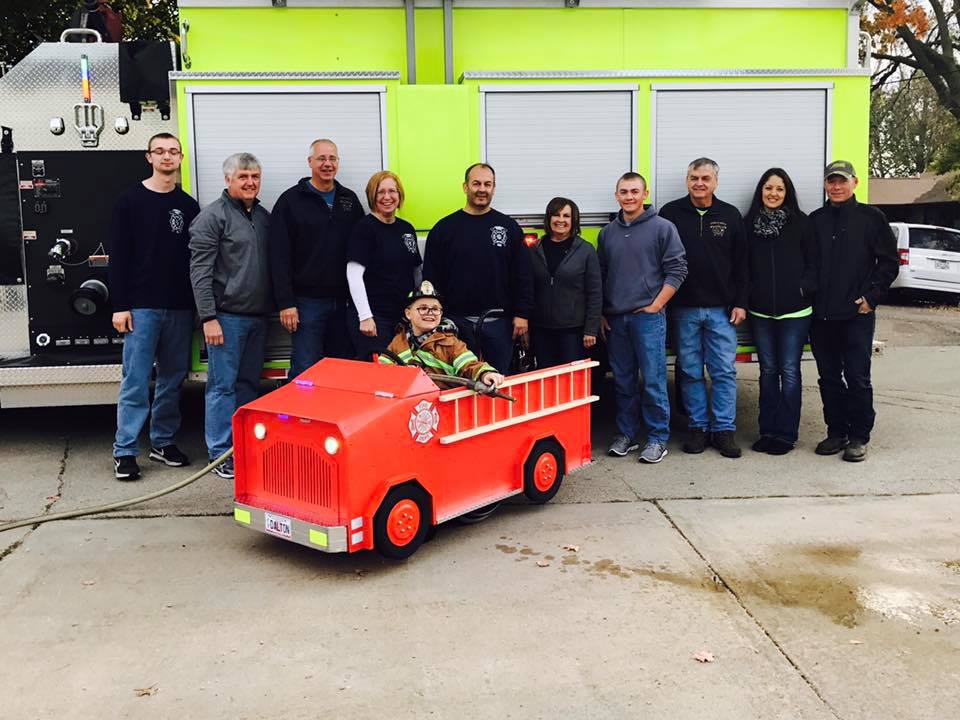
“We have a Builder’s Manual which lays out the process, helps our volunteers put a build team together, and also helps them in getting their community involved by fundraising and reaching out for local community support,” Ryan explains. “This is a wonderful way to build awareness in a community about families and kiddos like mine.”
Their first year, the organization built eight costumes, tripling to 24 their second year, and topping out at 50 last year. Their volunteer-based process and Builder’s Manual allows them to have a wider reach than if they were to rely on just one centralized headquarters team. “These are built all over the country! Local builders building for local kiddos.”
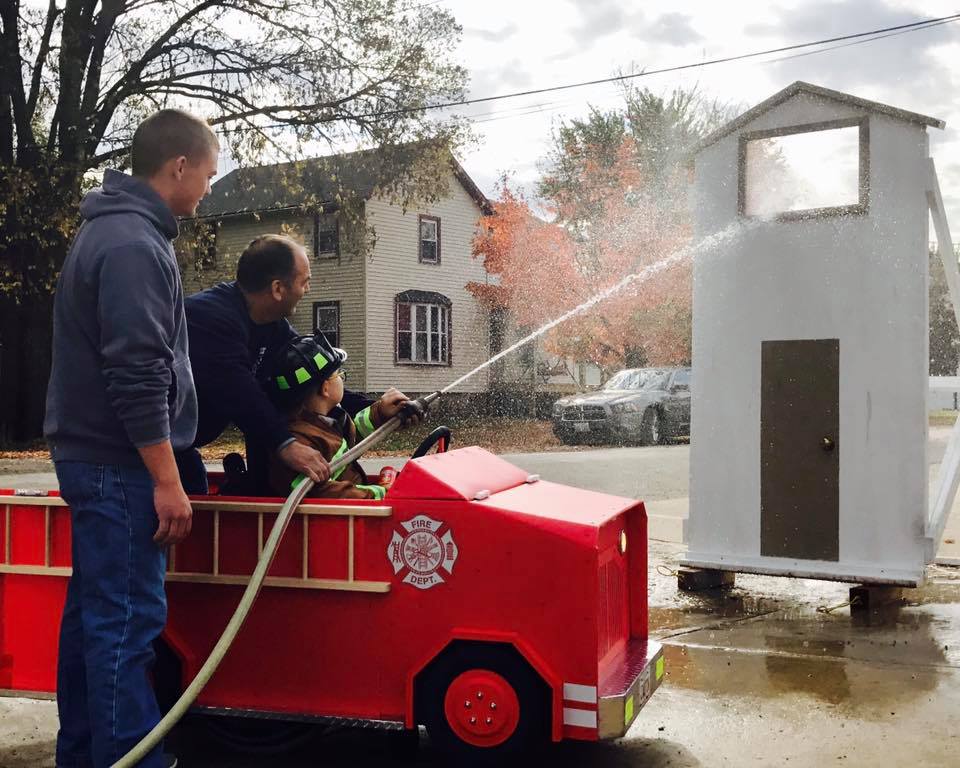
They’ve also received some amazing support along the way, building a relationship with the Stan Winston School of Character Arts. “The co-founders Matt and Erich both serve on the board of Magic Wheelchair, and as part of this amazing connection all of our volunteers get access to the school,” Ryan says. “We have cream of the crop special effects artists helping our build teams! The school has completely changed how I take a build on.”
The Magic Wheelchair and re:3D Worlds Collide
Costume-building has always been a strong use case for 3D printing.
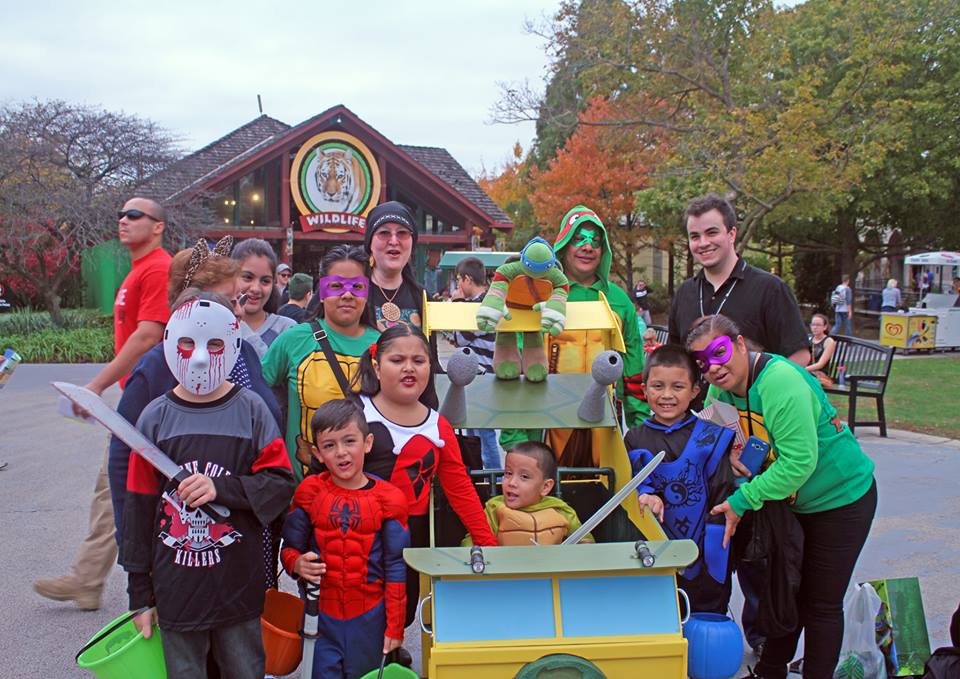
It’s often faster and cheaper than the alternatives, which could be anything from building and sculpting pieces by hand (time-intensive), or getting custom pieces made by a third party (costly). 3D printing also allows for quick and easy replication of parts- design one piece and you can just as easily print several for multiple costumes. We have quite a few Gigabot owners making custom costumes for Halloween, Comic-Cons, and cosplay events.
Through the collision of these two worlds and the power of social media, word of the Gigaprize found its way to Ryan.
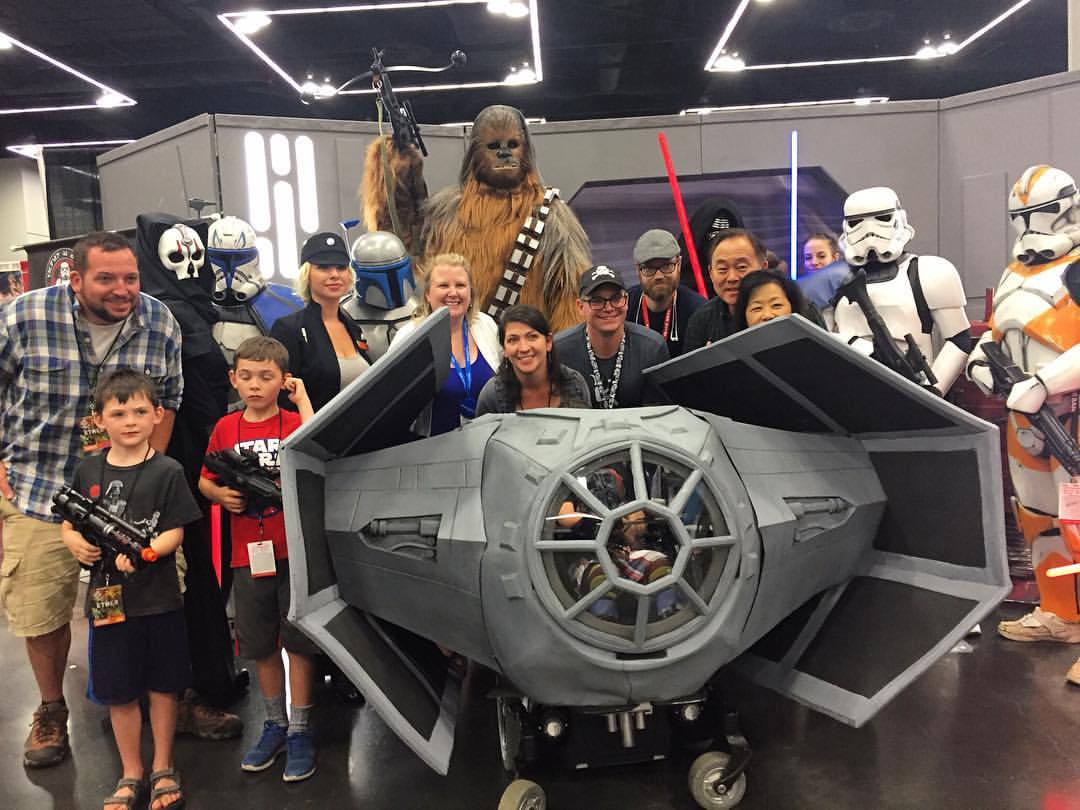
“We had a volunteer who met us at the Salt Lake City Comic-Con send us a message through Facebook to apply,” Ryan recounts. “We saw the opportunity and knew we had to go for it!”
The value of this technology in their line of work is unbelievably exciting to Ryan and the Magic Wheelchair team.
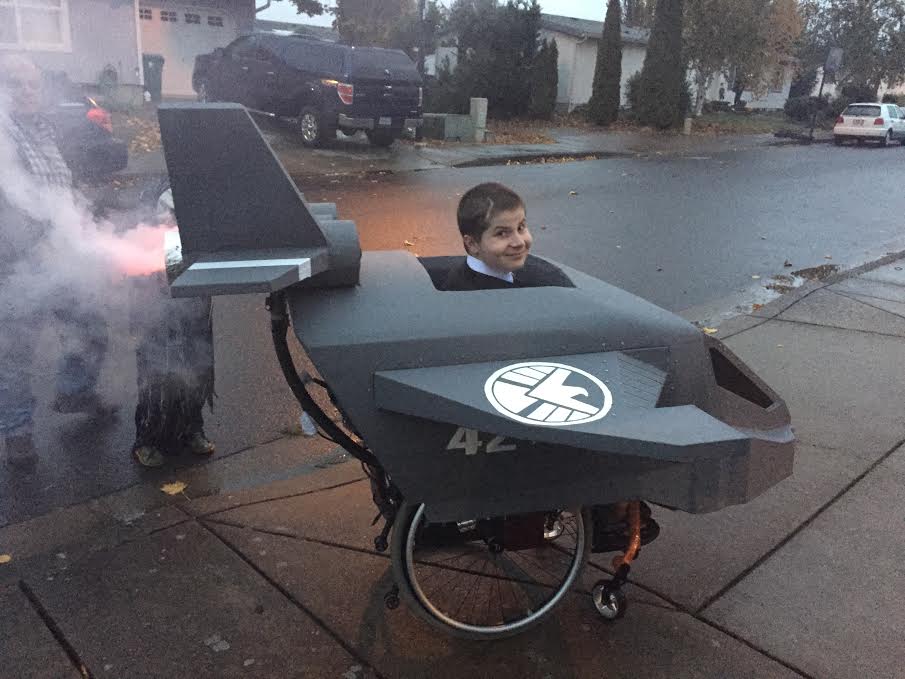
This allows us to do so many things in-house: from building kits, to making builds easier, to being able to do really specific detailed pieces and duplicating them for future builds. It really adds to that epic quality that we can kick out. 3D printers are quickly becoming commonplace in fabrication and special effects, so it’s going to be incredible having such an amazing printer in our hands. We have already had some 3D artists reach out to help, and we have a solid connection with Pixologic and the Zbrush community. Sky’s really the limit here!
Future Plans: Shoot for the Stars
Magic Wheelchair’s impact and growth each year has been nothing short of impressive, and 2018 is panning out to be no different.
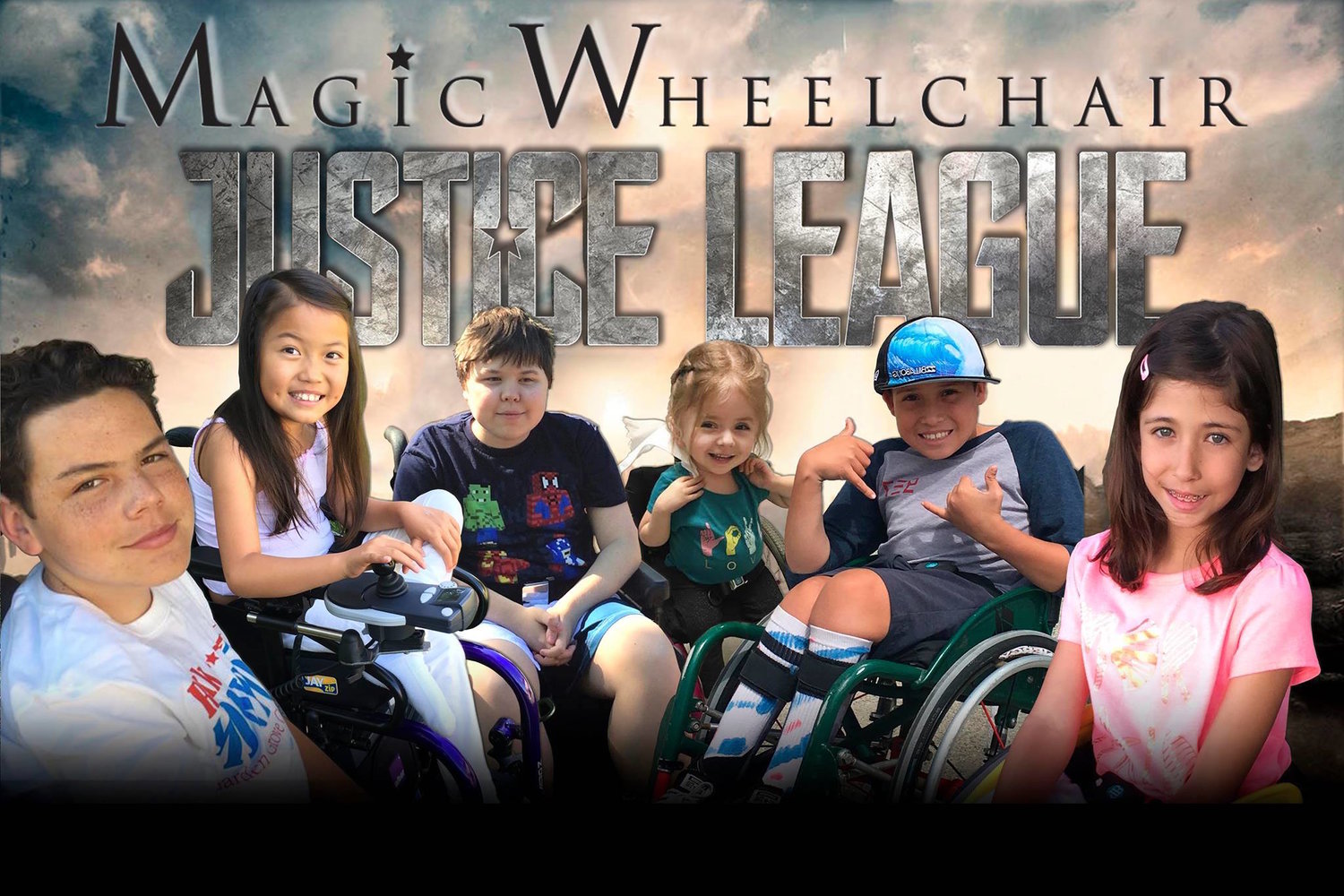
Though the first costume of each year is always a surprise, they can share the news that they’ll be returning to a favorite annual event: San Diego Comic-Con.
Last year they unveiled five Justice League-themed costumes on stage there with none other than Adam Savage. The segment is featured on Adam Savage’s Tested, Savage’s new project with old partner-in-crime Jamie Hyneman. If you’re having trouble placing their names, does Mythbusters ring a bell?
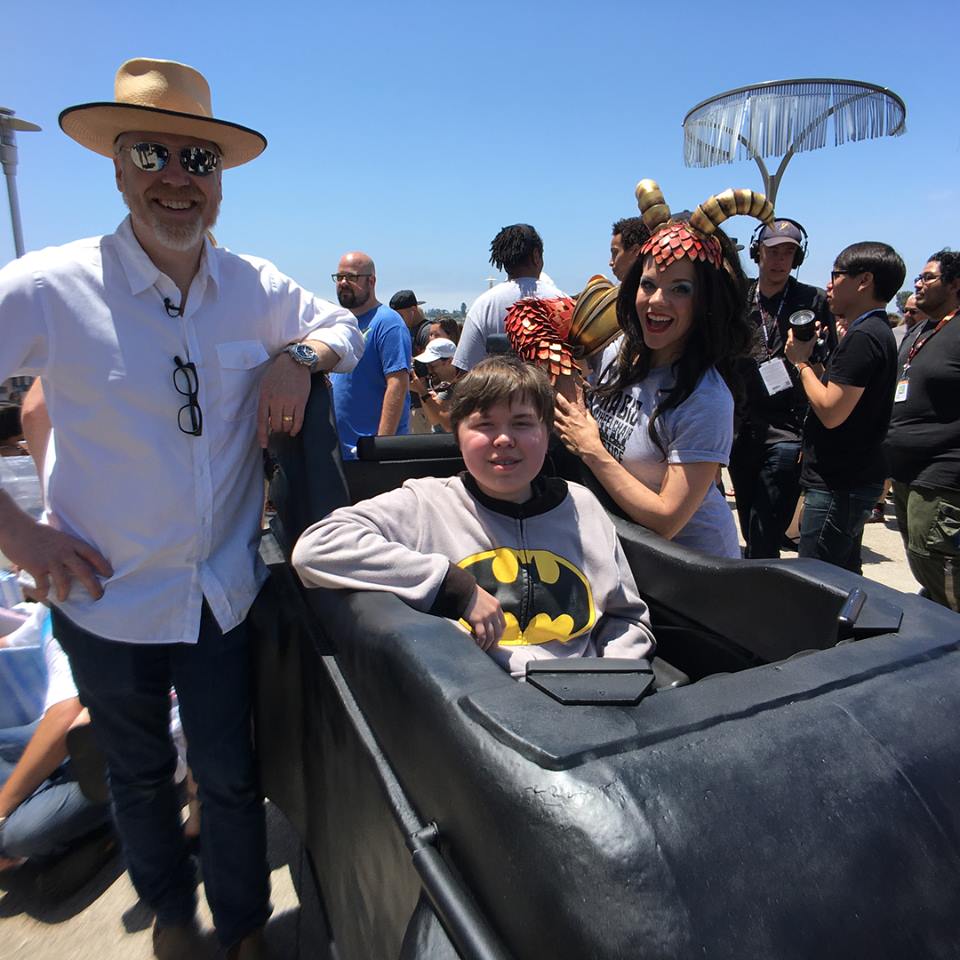
“This year we will be headed back to San Diego Comic-Con for a Star Wars-themed set of builds,” Ryan says. “We’re stoked!”
He’s especially thrilled that they’re collaborating with artists that currently work or have worked in the Star Wars franchise.
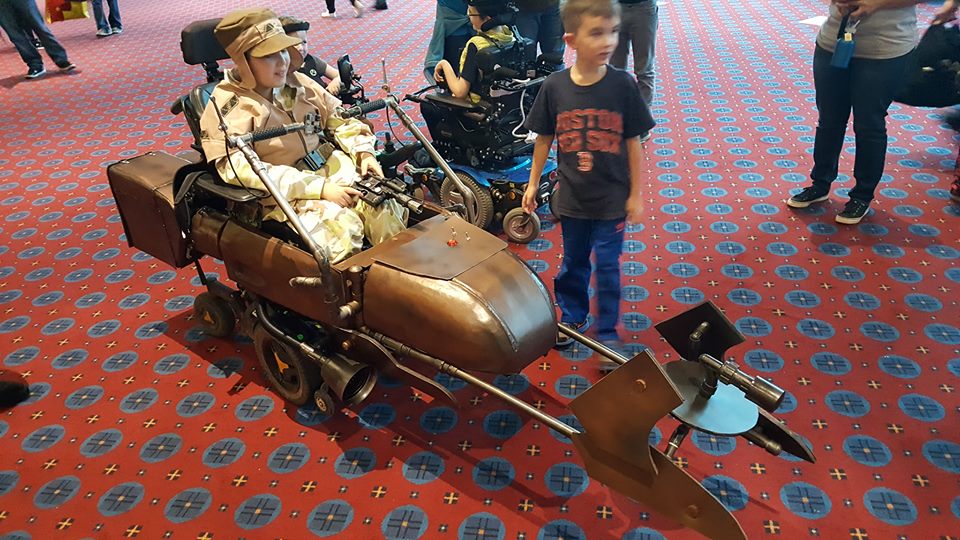
"I feel included."
Our goal with each Gigaprize we run is to get Gigabot into the hands of a deserving group who will put the machine to work doing good. Magic Wheelchair absolutely exemplifies this.

The work they do has ample room for a 3D printer to make a serious impact on their process, with the goal of allowing them to grow their reach by creating costumes faster and more affordably.
Magic Wheelchair’s impact is very real for the recipients of their work, which, as Ryan explains, transcends the category of “costumes.” “What we really are building are experiences,” Ryan explains. “Experiences that allow that barrier of ‘disability’ to essentially be swallowed up by these epic costumes.”
Ryan has been able to see that experience firsthand from day one when he built the very first costume for what would end up being Magic Wheelchair’s first recipient: his son Keaton.
“Keaton mentions this in every interview when he is asked what is his favorite thing about these costumes,” Ryan recounts. “Without skipping a beat he says, ‘I feel included.’ It’s such a beautiful thing.”
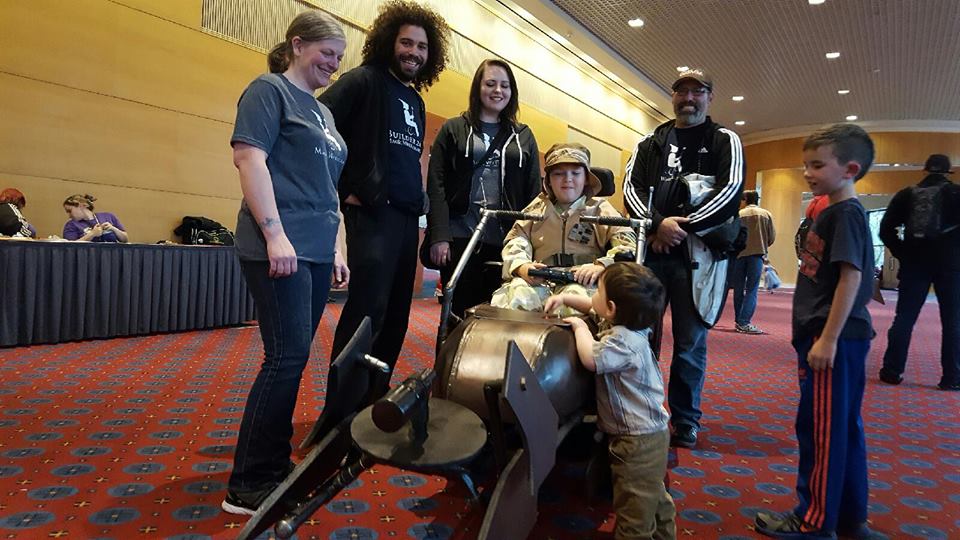
Magic Wheelchair relies on its network of hardworking and selfless volunteers. Consider volunteering your time for an experience that’s equally as rewarding for the people behind the costume as it is for the one wearing it. Learn more: https://www.magicwheelchair.org/volunteers
Morgan Hamel
Blog Post Author
Pitching for a Circular Economy: What We’d Do With a Million Dollars From WeWork
It’s Wednesday January 17th, 2018, and we’re in New York City.
Tonight we’ll be on stage at arguably the most well-known arena in the world, Madison Square Garden.
Seven incredible companies are by our side. One million dollars is on the line.
These are the WeWork Creator Awards Global Finals.

What are the WeWork Creator Awards Global Finals?
If you don’t already recognize the WeWork name, it’s time to get aquainted.
WeWork is, as their website says, a global network of workspaces where companies and people grow together. But it’s more than just office space. They’re the self-proclaimed platform for creators, and they’re putting their money where their mouth on this statement with the Creator Awards.
The Awards were “designed to find those world-changing ideas, put them in the spotlight, and give them the resources to go further.” In their words, they’re rewarding entrepreneurs, artists, startups, and nonprofits who are thinking in new ways and creating real change, supporting innovative projects and the people behind them. They’re putting millions of dollars into allowing people to fulfill their own personal versions of the WeWork mantra: “Create Your Life’s Work.”
Over the past year, WeWork has been holding Creator Awards around the world – from Austin (that’s us!) to Tel Aviv. Thousands of applicants, hundreds of regional finalists, and millions of prize dollars later, it comes down to tonight: the Global Finals.
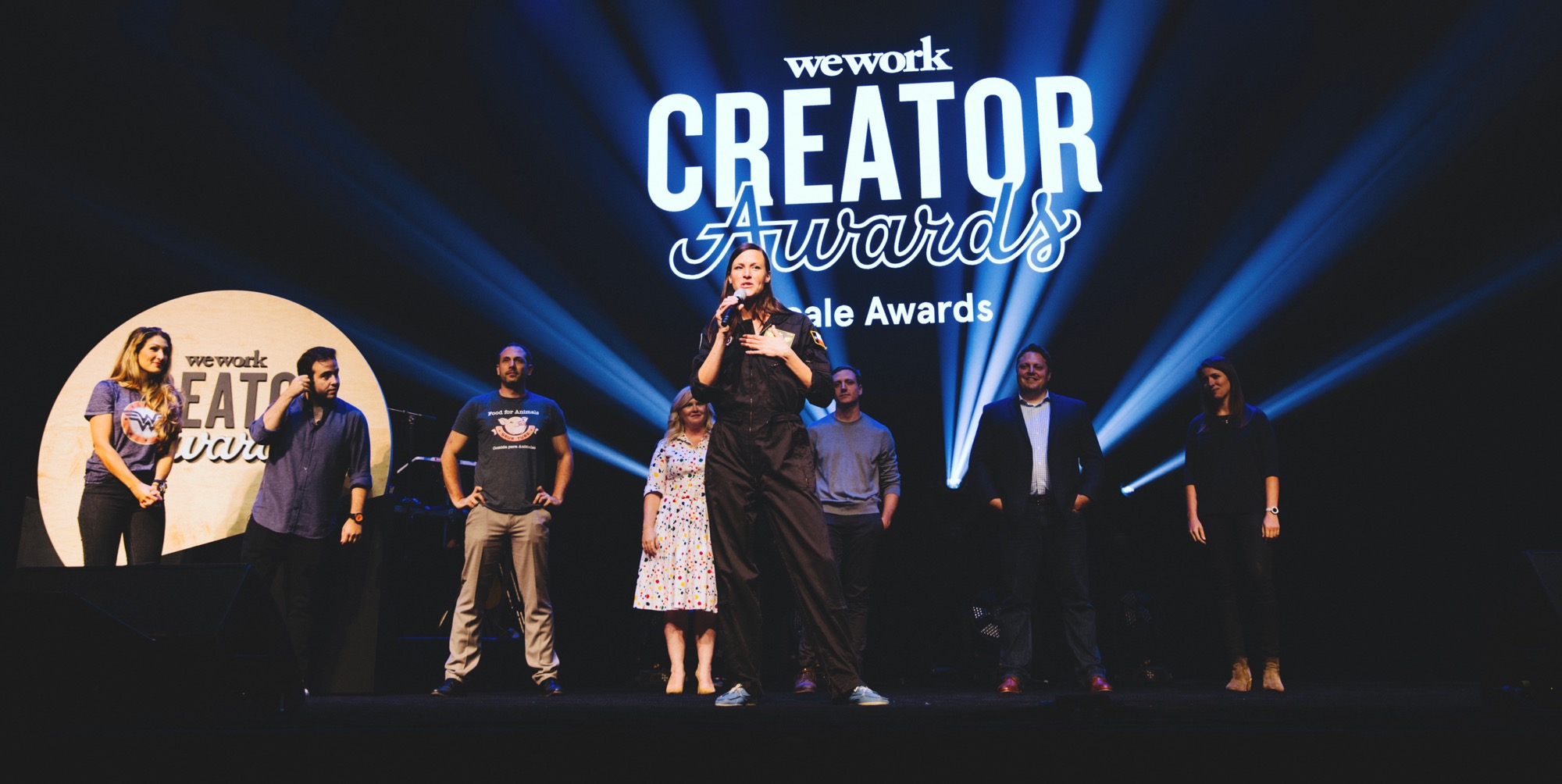
The Finalists
We’re in the company of people and organizations doing absolutely incredible work. The lineup is staggeringly inspiring.
There’s Becca Keaty, 20-year retired veteran of the Army National Guard representing Bunker Labs, a national non-profit empowering veterans and active duty service members with tools to start and grow their own businesses.
Elizabeth Lindsey from Byte Back, a Washington, D.C.-based non-profit improving economic opportunity for underserved metro area residents through computer training and career prep.
Manal Kahi and Wissam Kahi are the Lebanese sister-brother duo of Eat Offbeat, a company delivering home-style ethnic meals conceived and prepared by refugees resettled in NYC.
The CEO of Andiamo, Naveed Parvez, whose company in London is using data, biomechanics, and 3D printing to create affordable, custom, and fast medical braces and other devices.
Tel Aviv’s Or Retzkin, the CEO of EyeControl, creators of the first communication device that enables locked-in individuals like ALS patients to communicate using only eye movements, without the need for a screen.
Sebastian Jünemann of Berlin-based CADUS, a nonprofit humanitarian relief organization that has developed and implemented affordable mobile hospitals on the frontlines of crisis in Syria and Iraq.
And then there’s one wildcard, a mystery eighth finalist who will be chosen by popular vote from a group of six semifinalists.
Like we said, it’s quite the group.
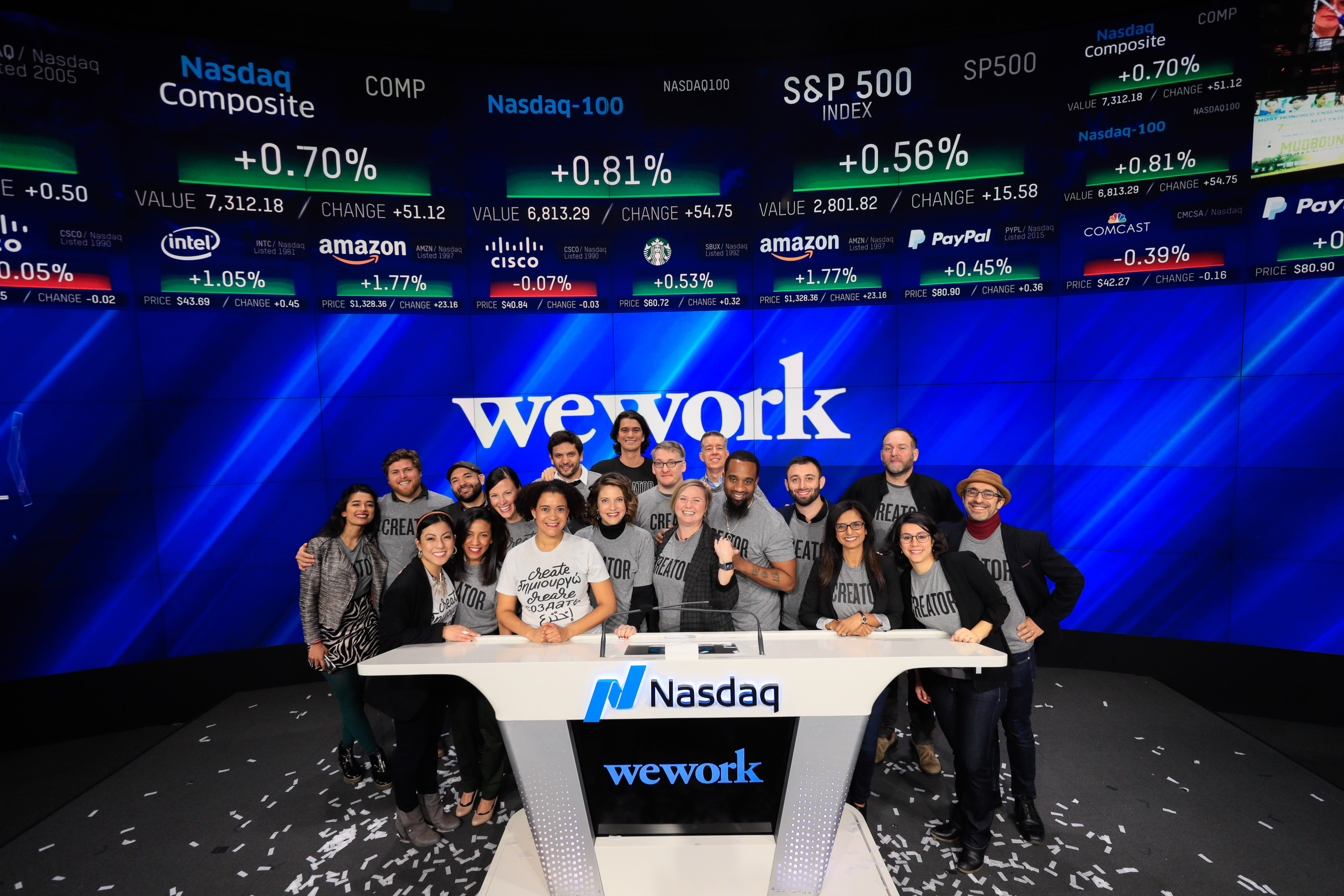
One Million Dollars
One million dollars. That’s the grand prize the eight of us are competing for. Each organization has unbelievably compelling reasons for how they’d use the money – we can’t say we don’t feel for the judges.
We know you’re curious – what’s ours? We figured you’d ask.
There’s a few different things we’d do with the money, with the main being the development and release of a system to 3D print from plastic waste. Thanks to the Scale Award we won at the WeWork Austin Creator Awards, we’ve been able to prototype a pellet extruder to 3D print using plastic pellets, including pellets made from recycled plastic. Here’s a video about our progress on that project and what’s still to come.
But our ultimate goal is bigger than this.
In order to fulfill the dream of able to shred volumes of plastic trash that would be dried and fed automatically into a printer, there are some resources we need. Winning the $1 million would provide us the financial resources to not only refine our pellet printer prototype to accept ground-up plastic water bottles, but also to allow us to engineer a grinder, dryer, and feeder system to allow people to truly manufacture from waste onsite.
It’s been our mission from the start to create a standalone system that could serve as an on-site factory, allowing a user to 3D print directly from waste. No matter what happens tonight, WeWork has helped take us one big step closer to that dream. We’re so thankful for this experience, the incredible people we’ve met, and the lessons we’ve learned along the way.
Best of luck to all the finalists tonight, and thank you WeWork for the adventure!
Morgan Hamel
Blog Post Author
Creative Commons Repost — Sharing a lost city: An innovative collaboration with re:3D and the New Palmyra project
The following is a repost of the Creative Commons blog post about our collaboration with them on the New Palmyra project. Article originally published on April 28, 2017 by Jennie Rose Halperin. Original article: https://creativecommons.org/2017/04/28/new-palmyra/
Sharing a lost city: An innovative collaboration with re:3D and the New Palmyra project
Together with re:3D, an Austin-based 3D printing company, and the #NEWPALMYRA project, a community platform dedicated to the virtual remodeling and creative use of architecture from the ancient Syrian city of Palmyra, Creative Commons has produced a 200 pound, 7.5 feet tall 3D rendering of one of the Palmyra Tetrapylons.
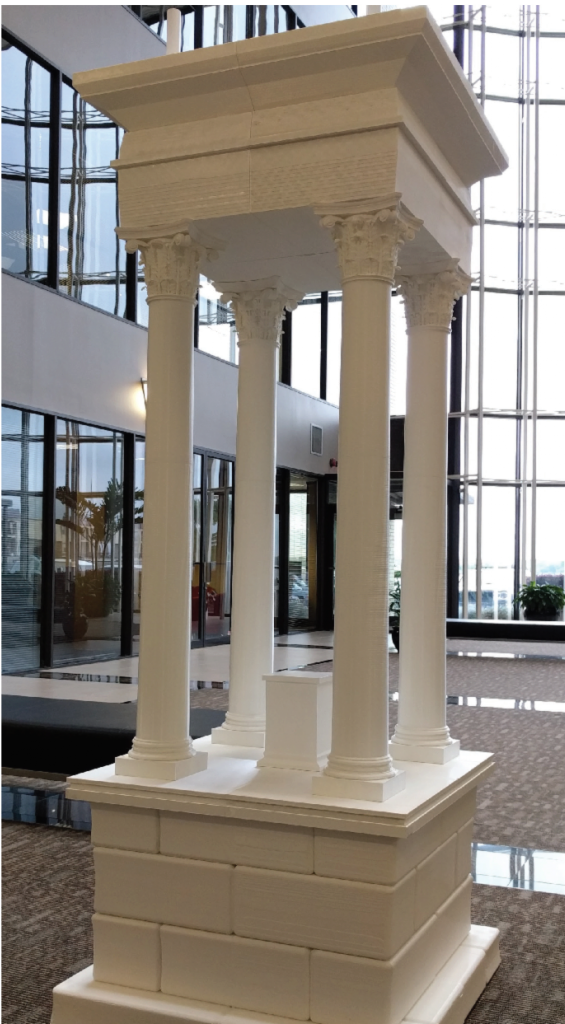
Together with re:3d, an Austin-based 3D printing company, and the #NEWPALMYRA project, a community platform dedicated to the virtual remodeling and creative use of architecture from the ancient Syrian city of Palmyra, Creative Commons has produced a 200 pound, 7.5 feet tall 3D rendering of one of the Palmyra Tetrapylons. This rendering will be on display at the Creative Commons Global Summit in Toronto, CA from April 28-30, bringing the commons to life through the work of its community.
This large-scale rendering is one of the four quad-column pylons, or gateways, that would have marked a central place in the city. Palmyra is a desert oasis, a UNESCO world heritage site, and is considered one of the most important global archaeological sites. Since 2015, large sections of Palmyra have been destroyed by ISIL and many of its precious artifacts lost or sold on the global market.
In January 2017, it was confirmed by satellite imagery published in the New York Times that Palmyra’s ongoing destruction by ISIS continues – including this section of the Tetrapylon.
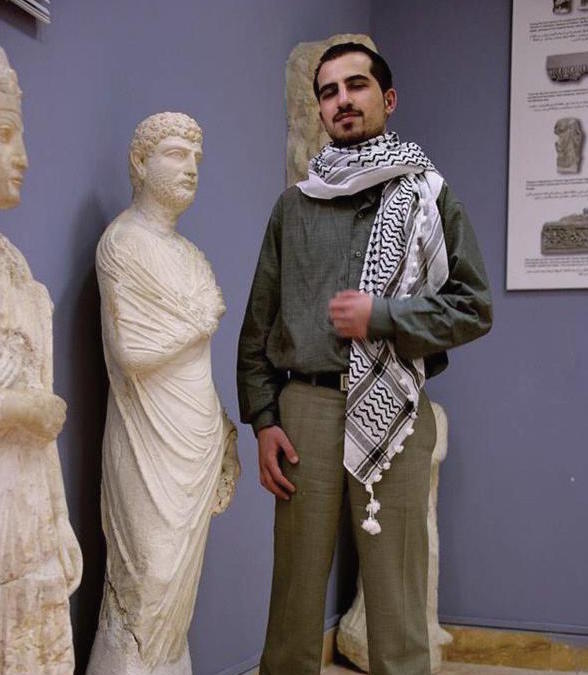
The #NEWPALMYRA project was begun in 2005 by CC Syria leader Bassel Khartabil, a Palestinian-Syrian open source software developer, educator, and free culture advocate. Working with the publisher Al-Aous and a team of artists in Damascus, Khartabil began remodeling the endangered ruins of Palmyra in 3D until 2012, when he was unlawfully imprisoned by the Syrian government. Much of this work was never published, though Bassel was committed to its free dissemination and use. In 2015, Khartabil was sentenced to death by the Assad regime. His whereabouts remain unknown.
A nonprofit founded by Bassel’s family, friends, and community, #NEWPALMYRA is freeing Syrian culture digitally, providing agency and advancement for the Syrian people through cultural heritage and digital preservation. Khartabil’s visionary work ignited a community that stands for transparency, openness, and free culture and continues to grow via the remix, reuse, and sharing of his foundational work.
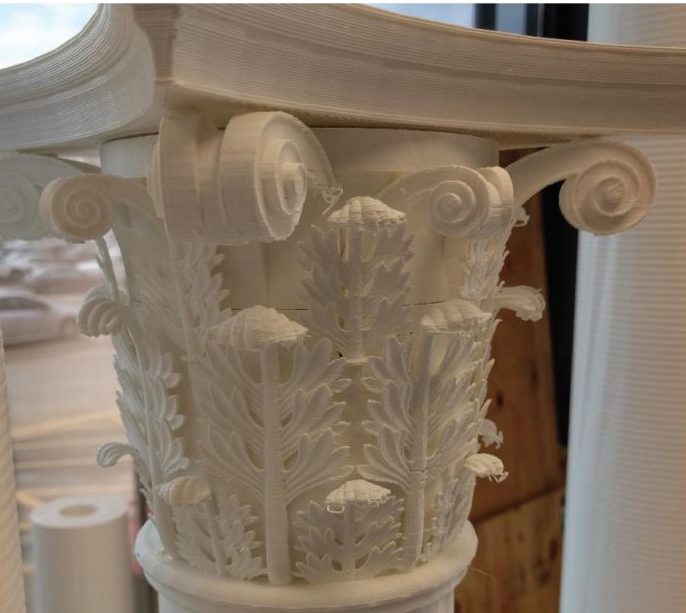
In the words of Ryan Merkley, Creative Commons CEO, “Creative Commons wanted to bring the commons to life for its 2017 Summit in Toronto. CC brought Austin-based re:3D together with the #NEWPALMYRA project team. The Gigabot, re:3D’s spectacular printer, renders massive models at commercial quality. Together, we produced a huge replica of one of the models of Palmyra: the Tetrapylon.”
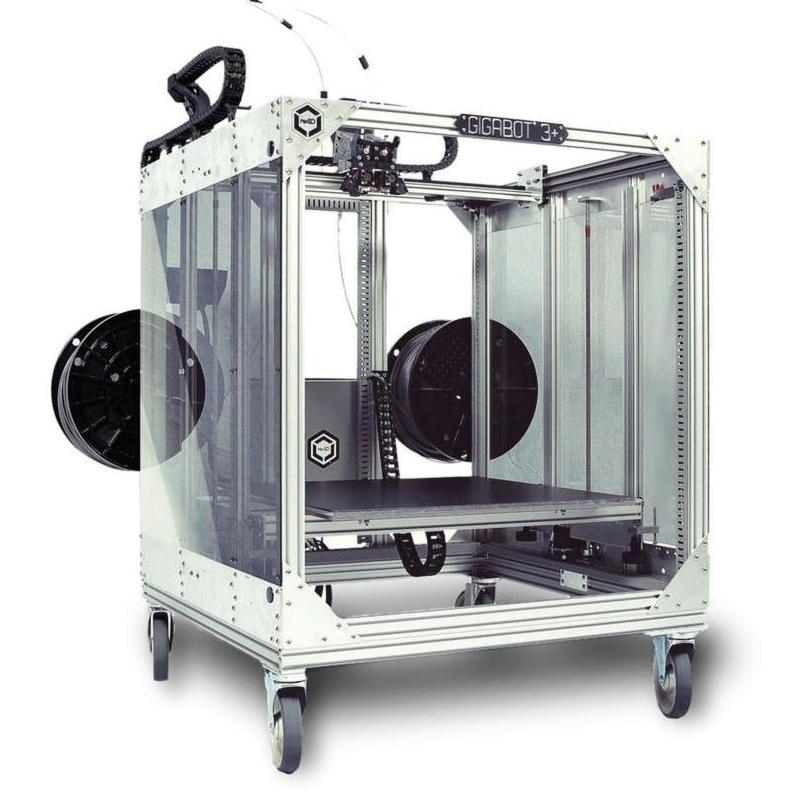
re:3D began with a digital 3D model of Palmyra provided by the #NEWPALMYRA team and transformed the digital into the physical using their Gigabot printer, which uses a rope-like filament resembling hot glue to precisely build the model layer by layer. Each layer is between .2-.6 mm thick, depending on layer of detail. The entire structure was assembled from 25 separate pieces with an internal wooden frame for support. It weighs 91kg and took about 800 hours to print.
As an in-kind sponsor of our Global Summit, re:3D Inc. participated in the project pro-bono, including the development, design, printing, and shipping of the final model to Toronto, Canada. re:3D is a full service socially focused additive manufacturing company based in Houston, Texas USA.
Creative Commons would like to thank re:3D and #NEWPALMYRA for their collaboration on the project and commitment to the global commons. Follow us on social media for pictures of the display on our Twitter,Facebook, and Instagram.
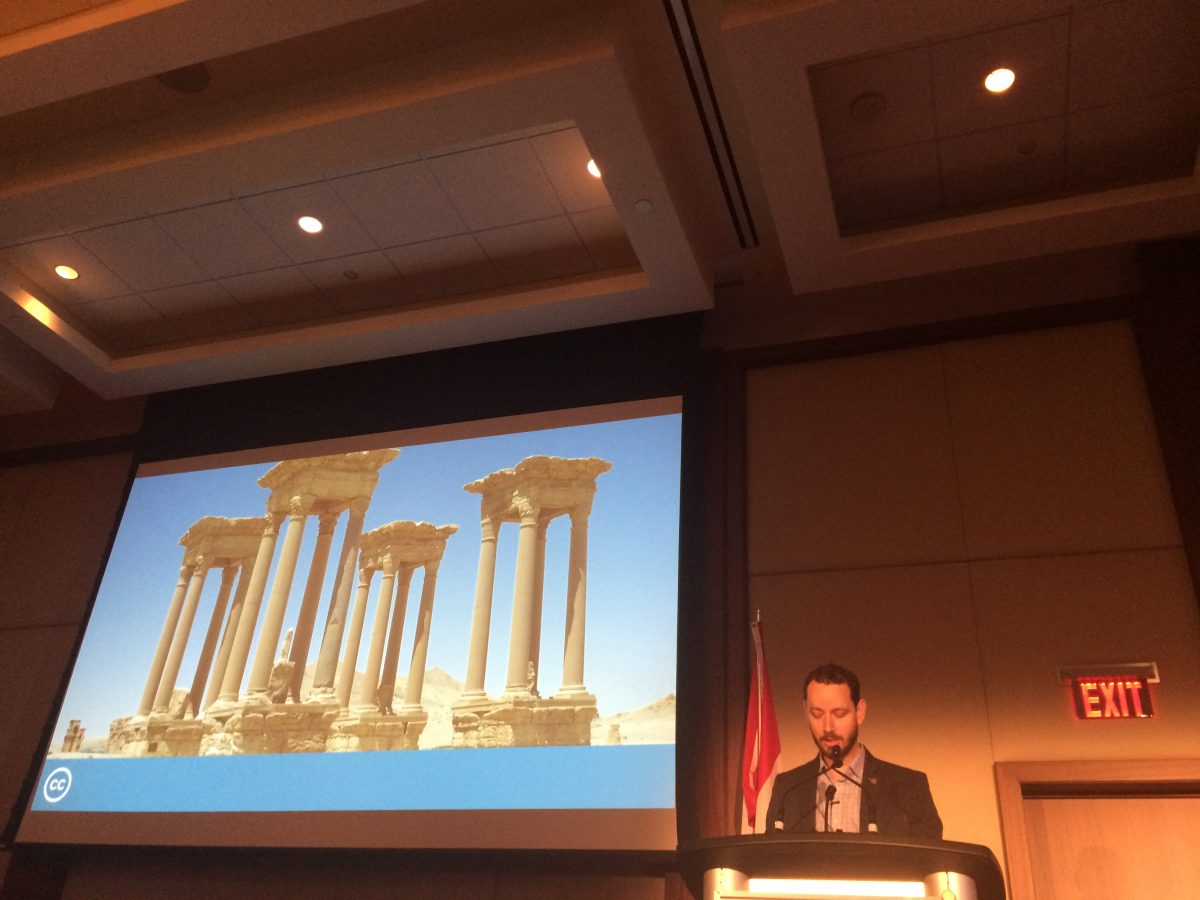
Zero to Factory: Why We’re Sharing our Experiences Being Scrappy
Week 1
As an optimistic group of underdogs we firmly believe that anyone, anywhere, anytime, should have access to their own personal factory while controlling their supply chain. With this vision we launched re:3D Inc– a social enterprise committed to making human-scale 3D printing available to emerging markets.
Our flagship technology is the Gigabot, an open-source 3D printer, which cost per scale remains one of the most affordable industrial solutions on the market. We launched Gigabot on Kickstarter during participation in Start-Up Chile, which catalyzed our sales and gave us a small nest egg to get started. However, producing & shipping a toilet-sized 3D printer required many considerations not originally scoped in the budget that drove our initial price-point. Rather, we found ourselves investing as much energy into standing up a garage-based factory that is now scaling into a proper warehouse in Houston as well as a satellite office in Austin. Wanting to save money on your business utilities? Have a look at sites that offer business electricity comparison deals and see if you can start saving money on your bills.
With an ultimate goal to enable Gigabot to 3D print from plastic trash, we’ve had to work hard to preserve our social genesis despite being lean. One reflection of our passion for impact is though the Gigaprize, whereby we donate one Gigabot for every 100 sales to an organization working to make-a-difference through 3D printing.
Why we are starting a blog on Medium:
While re:3D keeps a blog that highlights our activities in the affordable, large-scale 3D printing domain, we recognize that the our experience is part of a larger narrative. Our story has admittedly been both physically & emotionally taxing as we continue to invest our savings, blood, tears, sleep, ruined clothes & a lot of giggles into building our future. By leveraging the reach of Medium we humbly submit our successes & failures for consideration to others pursuing bootstrapping a hardware company.
Beginning today, and subsequently for the next 52 weeks, we intend to share our open-source, socially-focused, boot-strapped experiences in hardware. Although initially we’ll be offering ourselves as a case study in crowdsourcing, inventory management, quality controls, export compliance, contracting, new tech sales, pitching, and customer support, we’re hoping to feature guests posts from other hardware veterans as well. Other businesses looking to improve the management of their facilities and make other aspects of their operations more efficient may want to consider implementing Axxerion’s computerized maintenance management system to do this.
We welcome requests on future topics, offers to guest blog, and feedback on whether we should continue documenting our lessons learned once the series concludes!
Show Us Your Print!
Customer Badge Campaign
Receive cool swag & recognition for your print milestones!
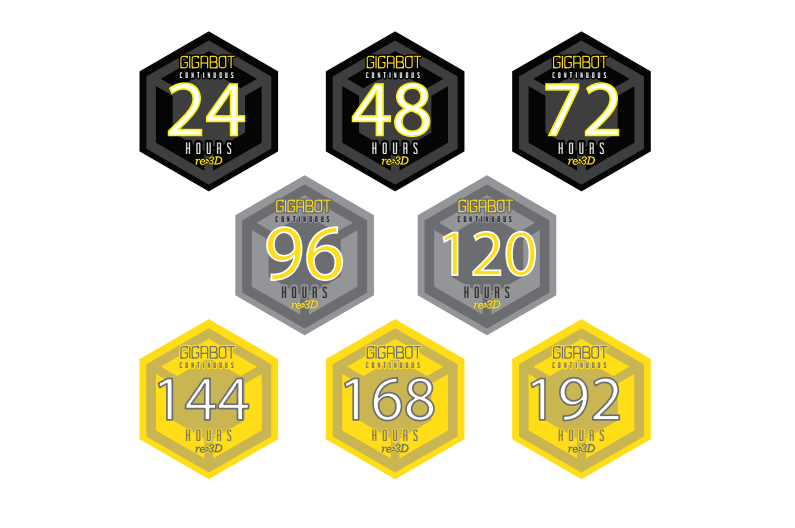
We’re awarding digital & physical patches to commemorate your 3D printing milestones on Gigabot in 2017! Simply email info@re3d.org with a link to your YouTube and/or Vimeo timelapse or a picture of your Viki & final print!
Winners will be announced on our forum (including the current record holder:)
Happy Printing!
~Samantha
Pitching for a Circular Economy Part 1: Why We Went to Aruba
Musings From Our Amazing Experience at the ATECH* Conference

As I sit on a plane flying in the opposite direction of Aruba I feel there is nothing more important than finding a way back. You see, Samantha & I spent the past three days as co-founders immersed in a new culture with new people and pitching an idea that is new and maybe just ahead of it’s time. The event that brought us all together is Atech2016. There exist in the paradise of an island nation of Aruba a group of inspiring founders who for the second year now have decided to put their money on the table. These visionaries invite tech savvy entrepreneurs and guest speakers to discuss thoughts and ideas on topics ranging from mobile banking & blockchain technology. I’m just glad we did research into sites like https://beincrypto.com/tag/coinbase/, as this meant that we were kept up to date with all things relating to the blockchain industry. We even looked into wearable tech & social inclusion from the perspective of Burning Man to inspire each other as well as the local Arubans how we as a society maintain relevance in the age of acceleration that we are living.

Gatherings like Atech2016 are really the nexus, bringing together in one place a group of young individuals with passion, focus, and hunger for change. With connections made, and new ideas formed we are all contemplating our next steps as we fly in the opposite direction of Aruba. We feel honored to have been part of such an event and encouraged by many Arubans who resonated with re:3D’s vision and our pitch for the Atech and Aruban communities. We were stoked to be named finalists in the pitch competition, and, while we didn’t win left more determined than when we arrived.
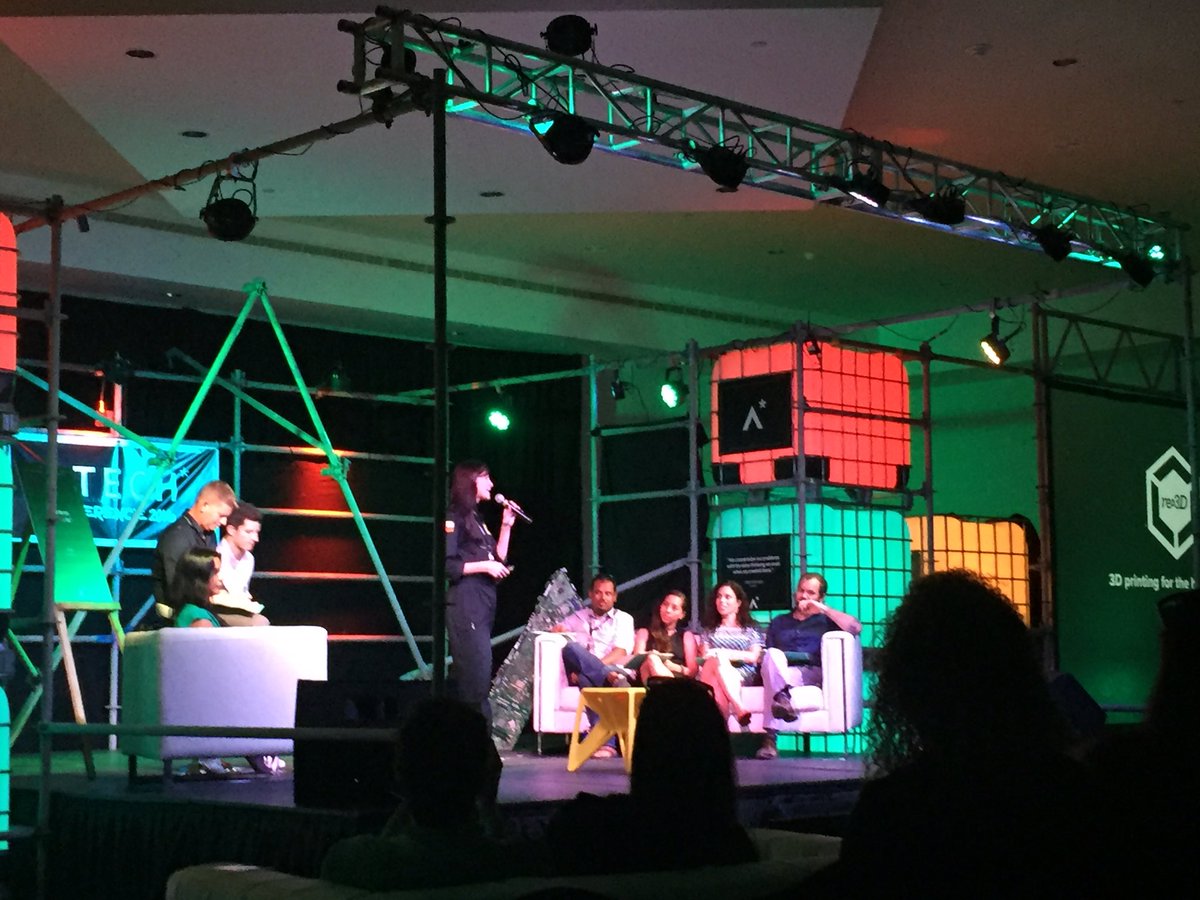
Several things became clear to us in the few short days we spent on the island:
- Arubans are ready, in fact hungry, for greater technology. Meeting and talking to the young men and women volunteering at the conference we felt their excitement for 3D printing as well as other technology on display.
- The island nation of Aruba is resource constrained and imports the vast majority of all their physical goods. There is very limited manufacturing on the island.
- With an economy largely based on tourism and very little to nonexistent recycling program there is a growing problem with trash and landfill space.
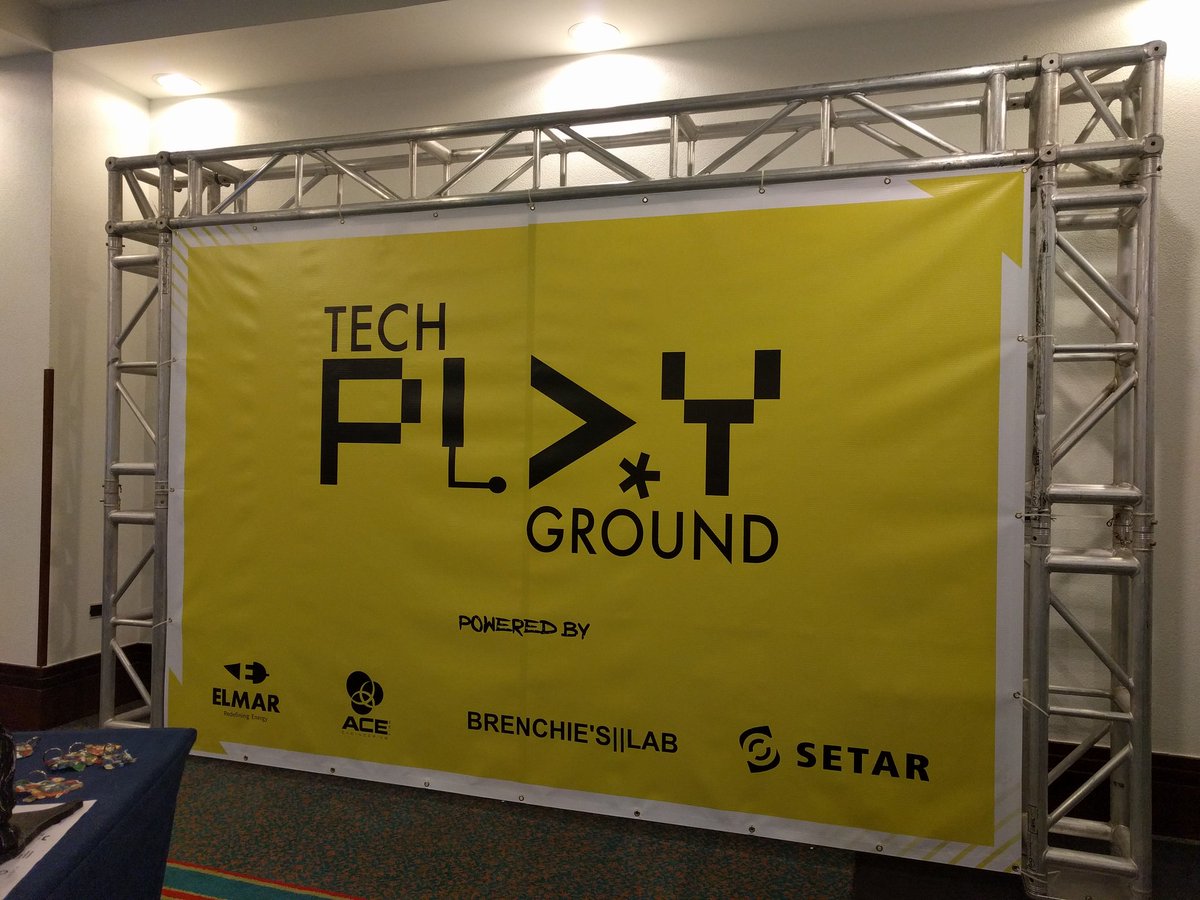
Our goal and dream, that which we pitched to Aruba, was that re:3D would engineer and manufacture the prototype hardware needed to take the first step in 3D printing useful objects from plastic trash. During our few short days at the conference, we reached out to community leaders, local entrepreneurs, Aruban schools and universities and well as hotels to partner in the effort of recycling, re-using and re: imagining the possibilities to own their our factory as well as the supply chain. The response was super positive and affirmed for us first – hand there was a HUGE opportunity to leverage trash for a more circular economy.
Why is this important?
- Sustainability goals are a priority in Aruba
- Island communities are significantly dependent on imports
- Arubas are actively innovating new solutions to reduce landfill size
- Several groups all already considering 3D printing from reclaimed plastic (and we hope to someday partner with them!)
Where do we go next?
While we left Aruba affirmed that 3D printing from waste is inherently right, we unfortunately did not secure the resources we needed to complete a prototype to leverage reclaimed plastic using Gigabot. Stayed tuned to upcoming blogs in our series as we continue to share our vision in future competitions and pursue partners to donate post-manufacturing waste streams to test. With a little luck, we will raise enough support to partner with Aruba on a pilot!
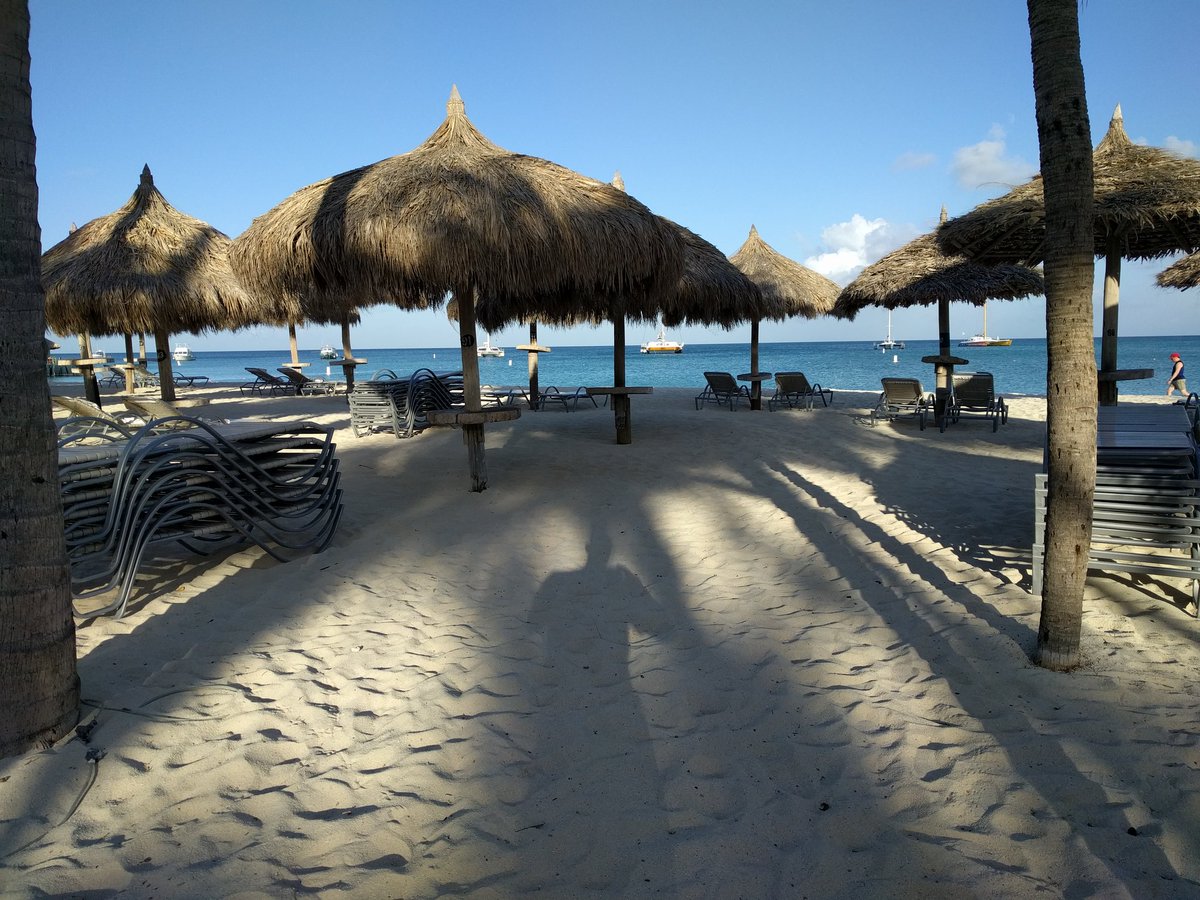
~Happy Printing!
Matthew Fiedler
Blog Post Author
